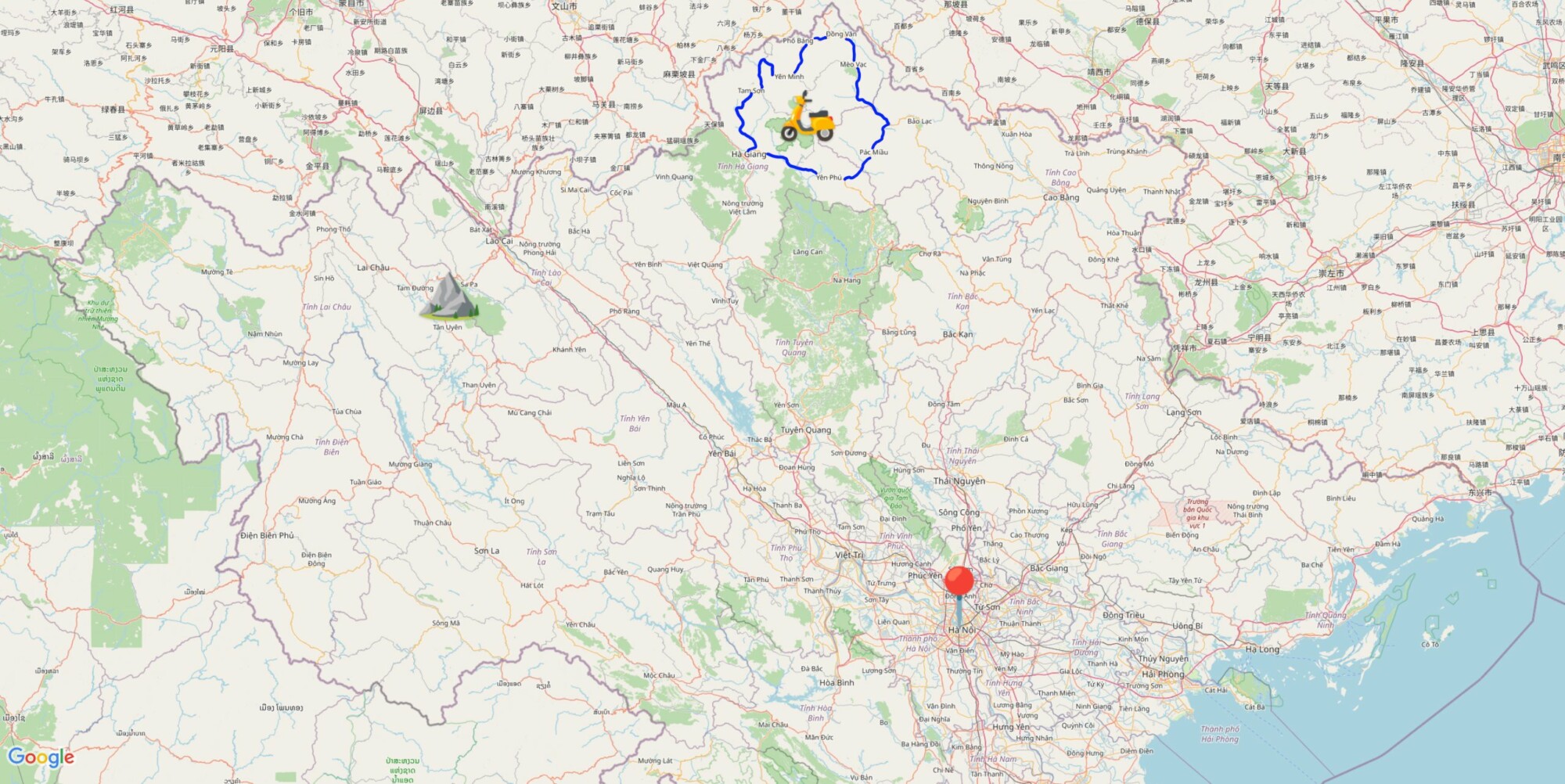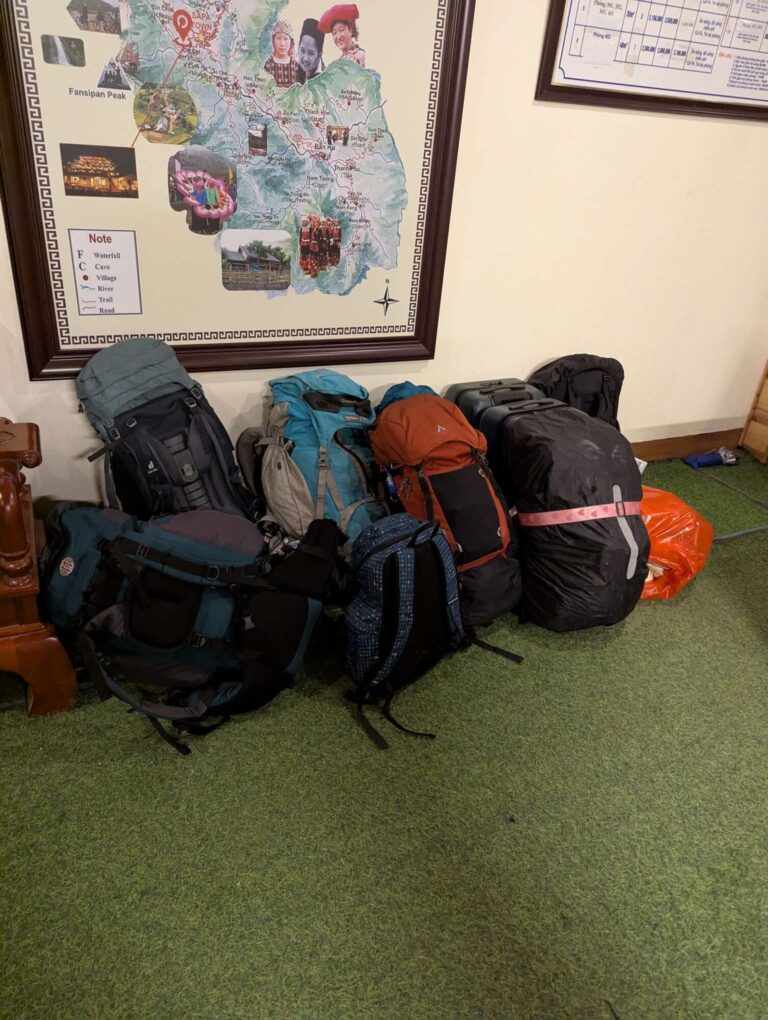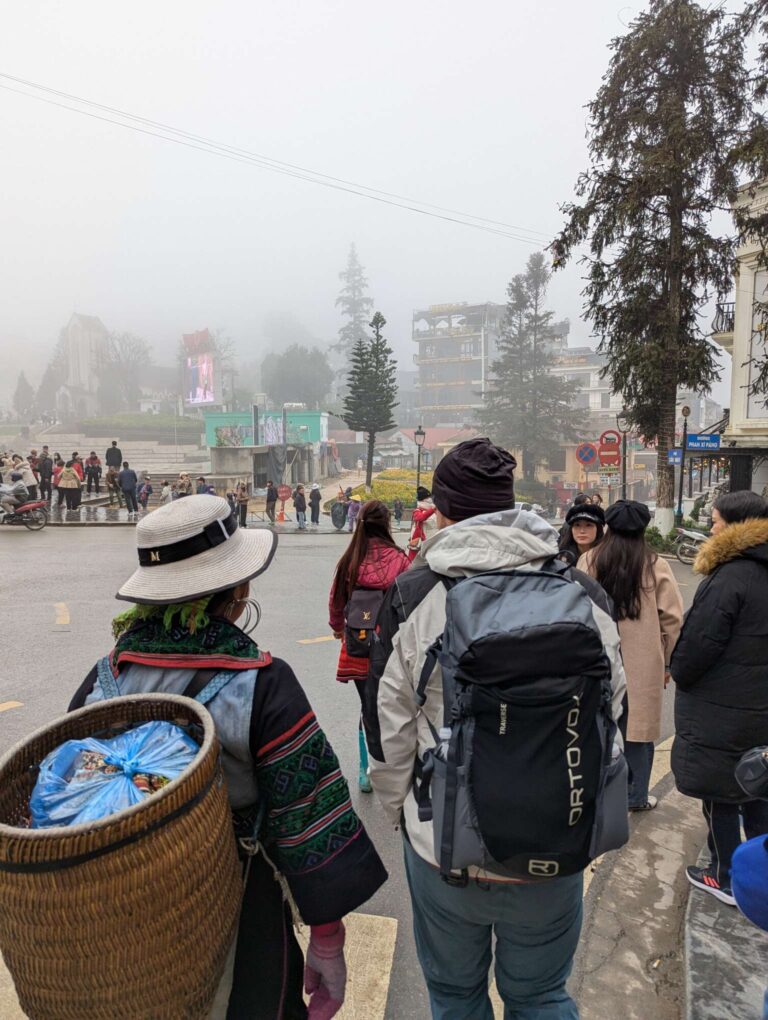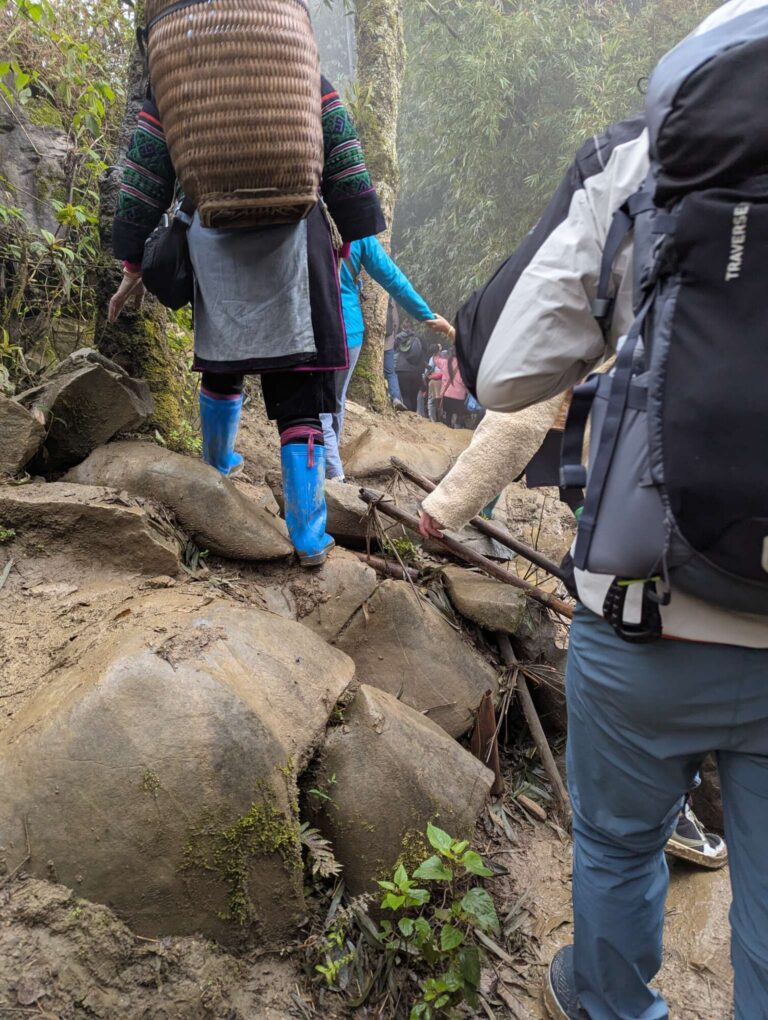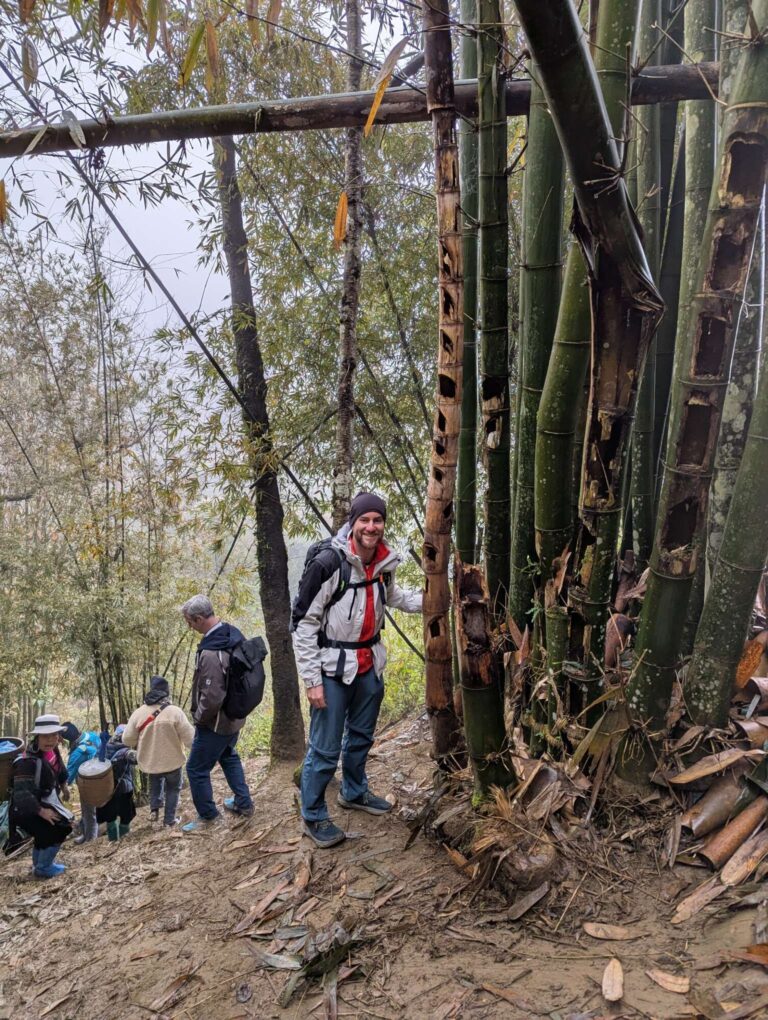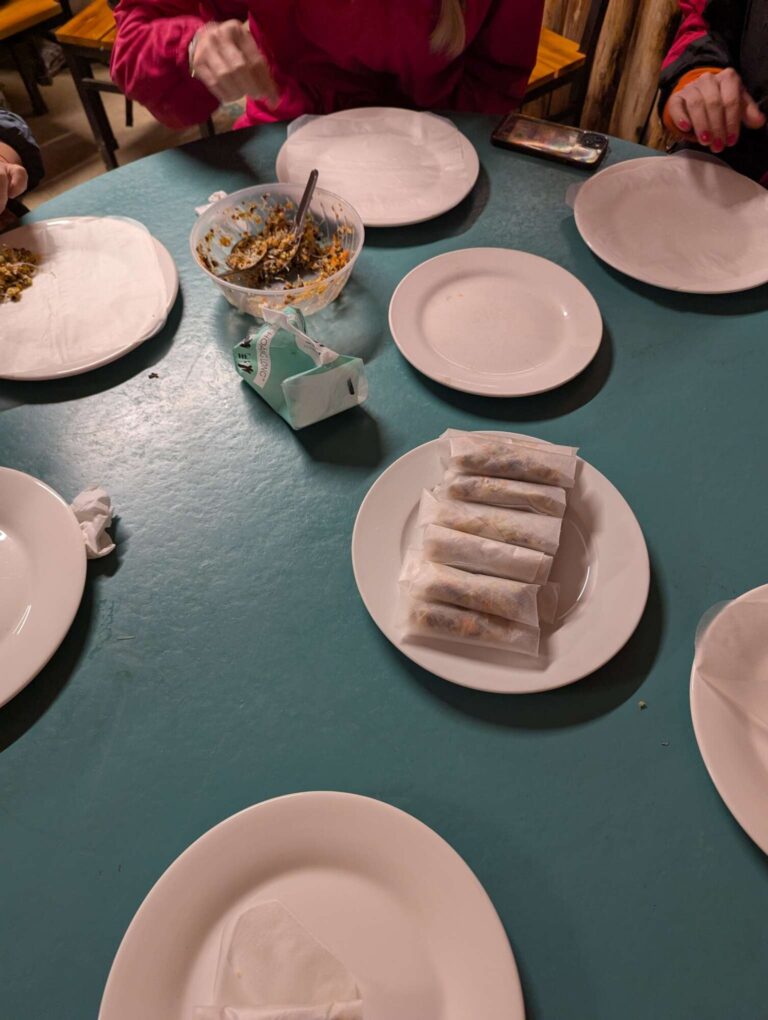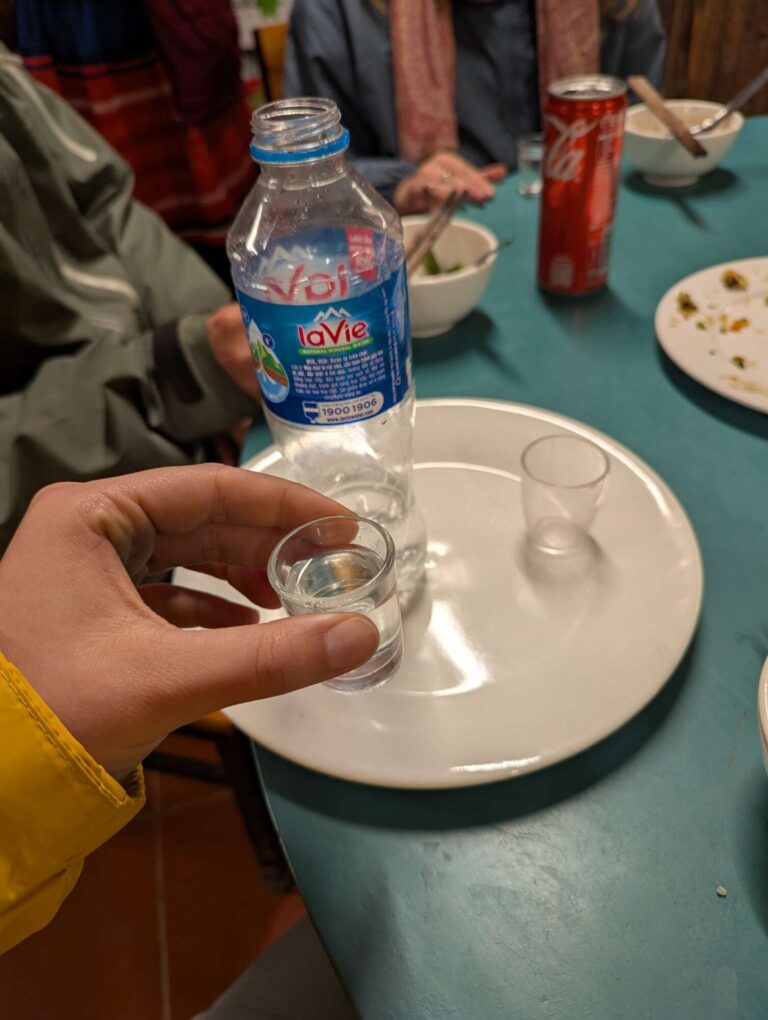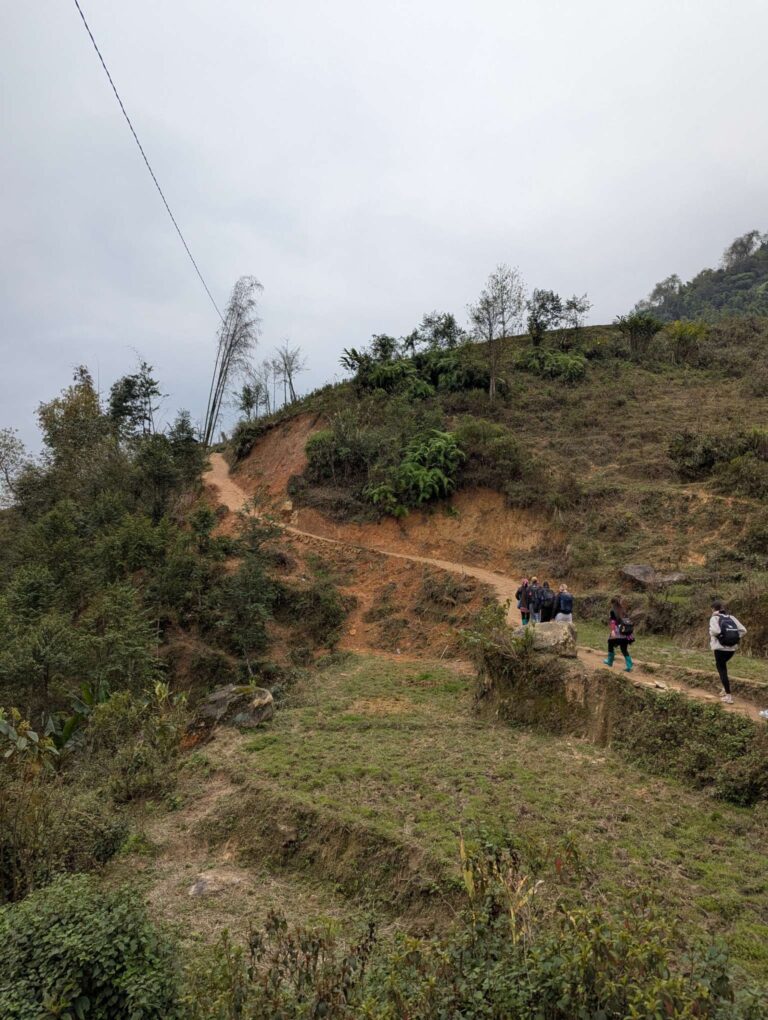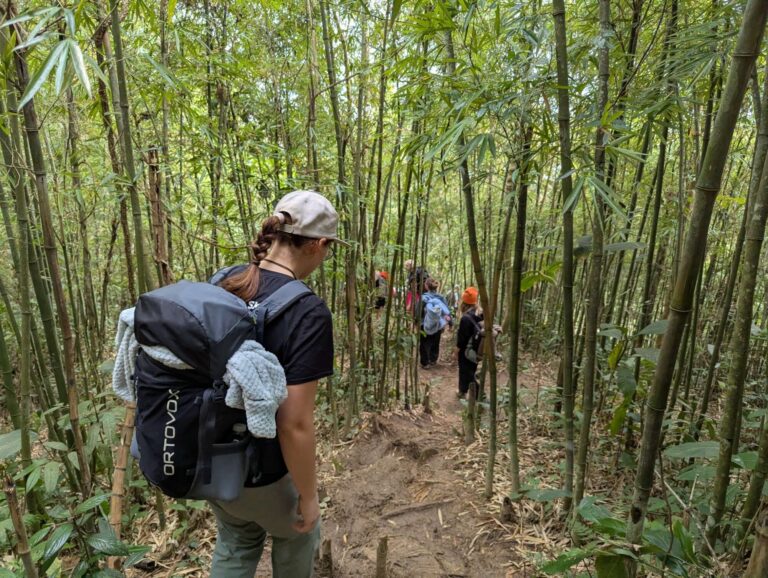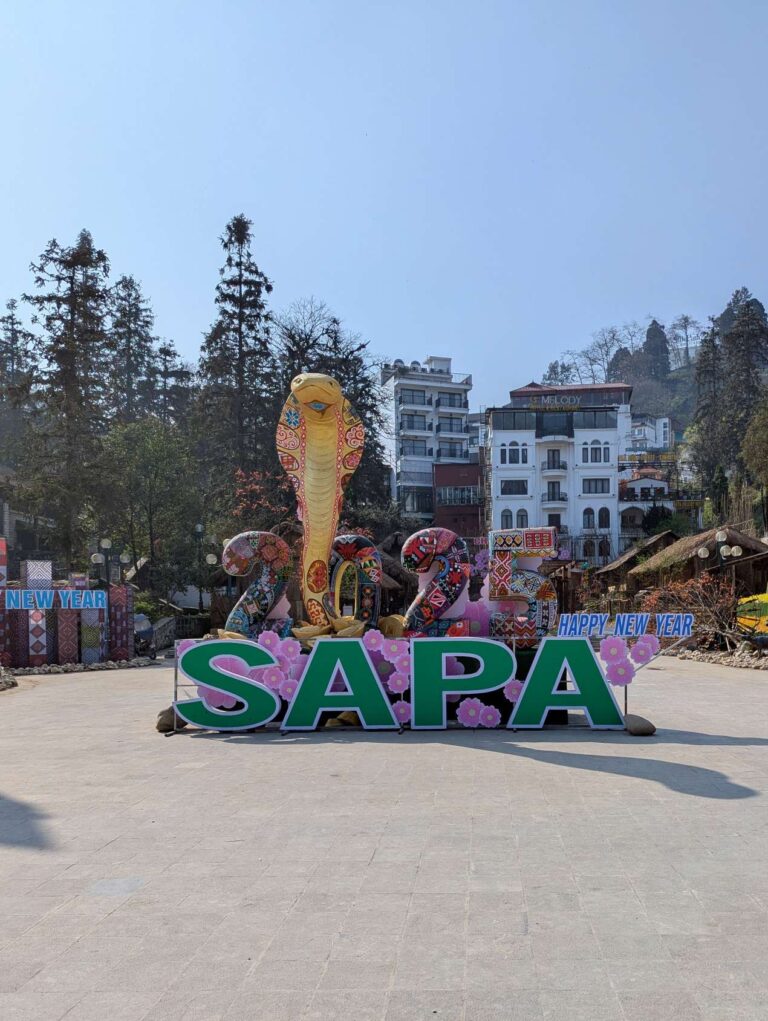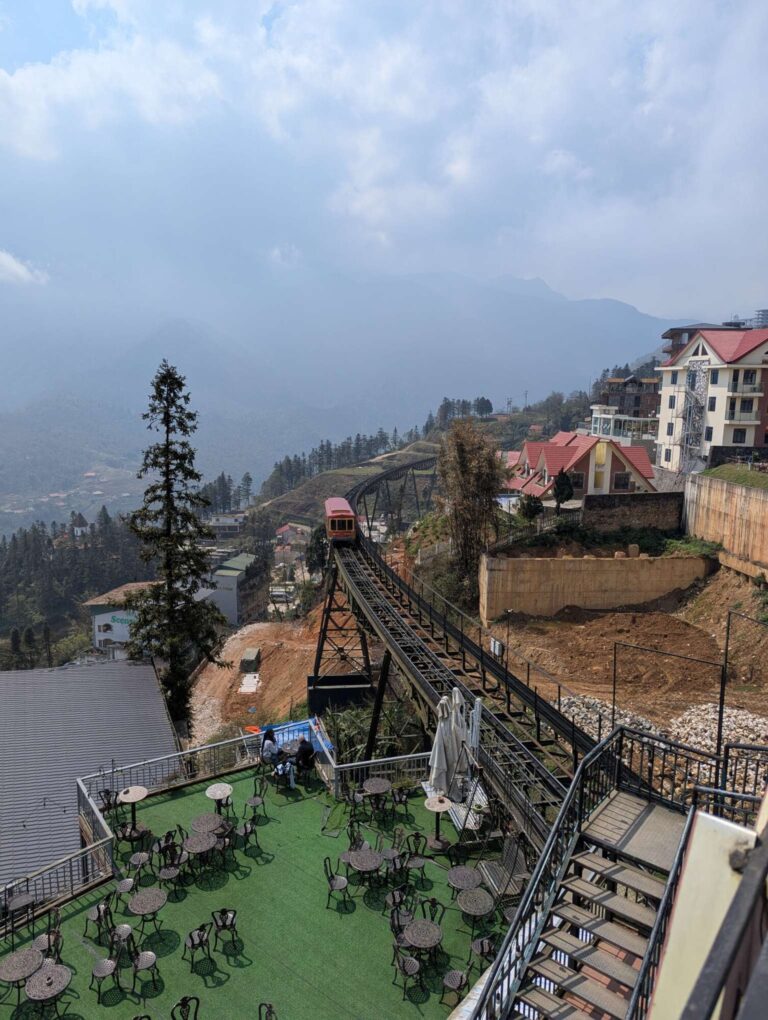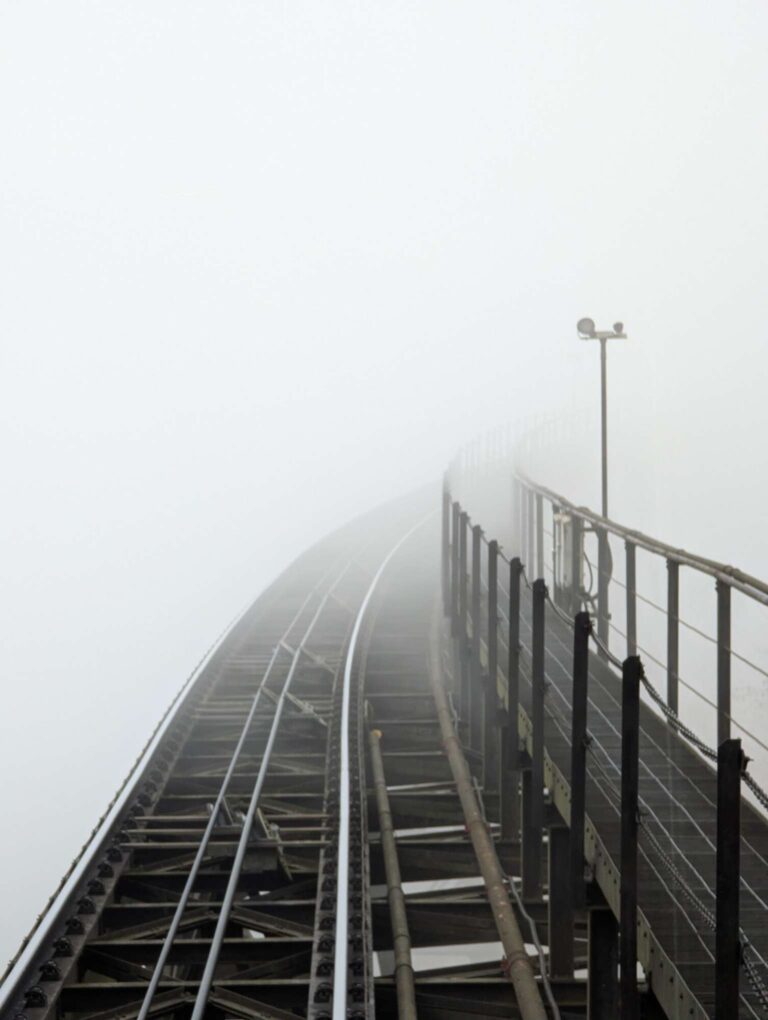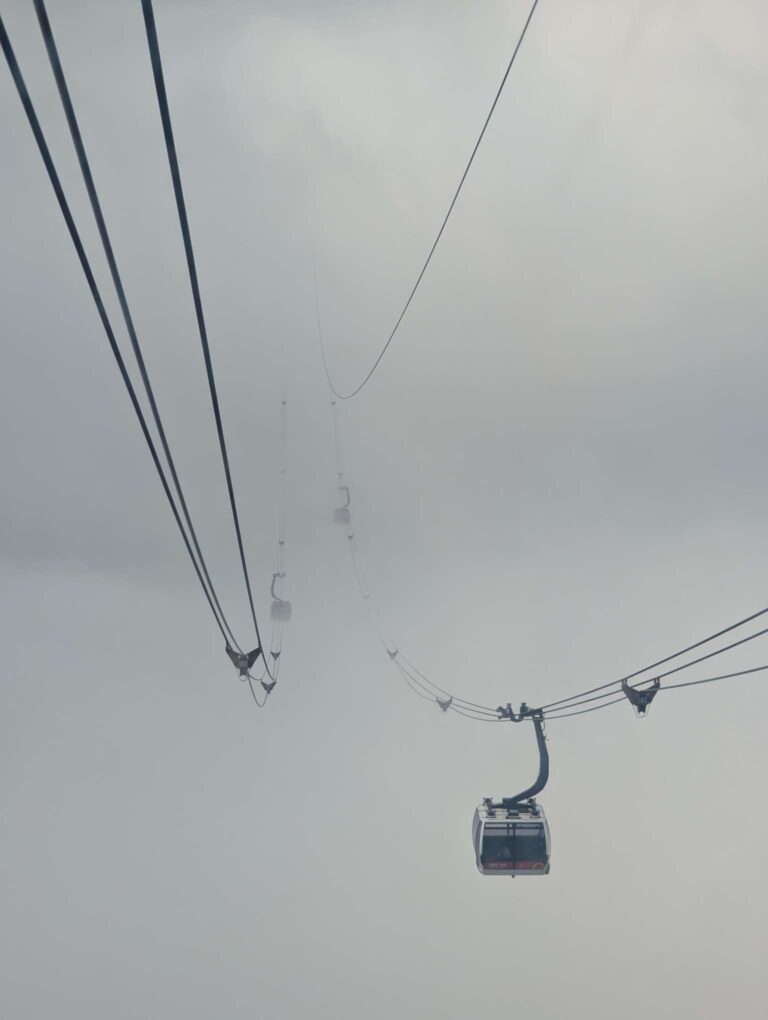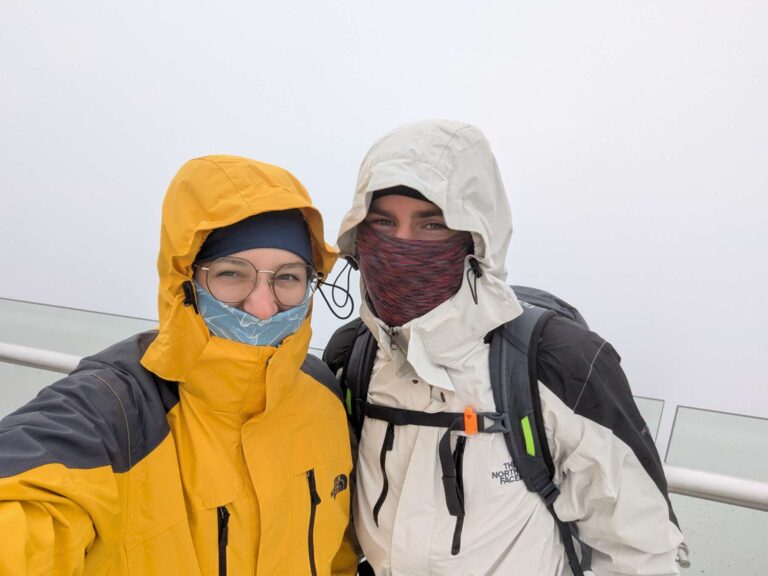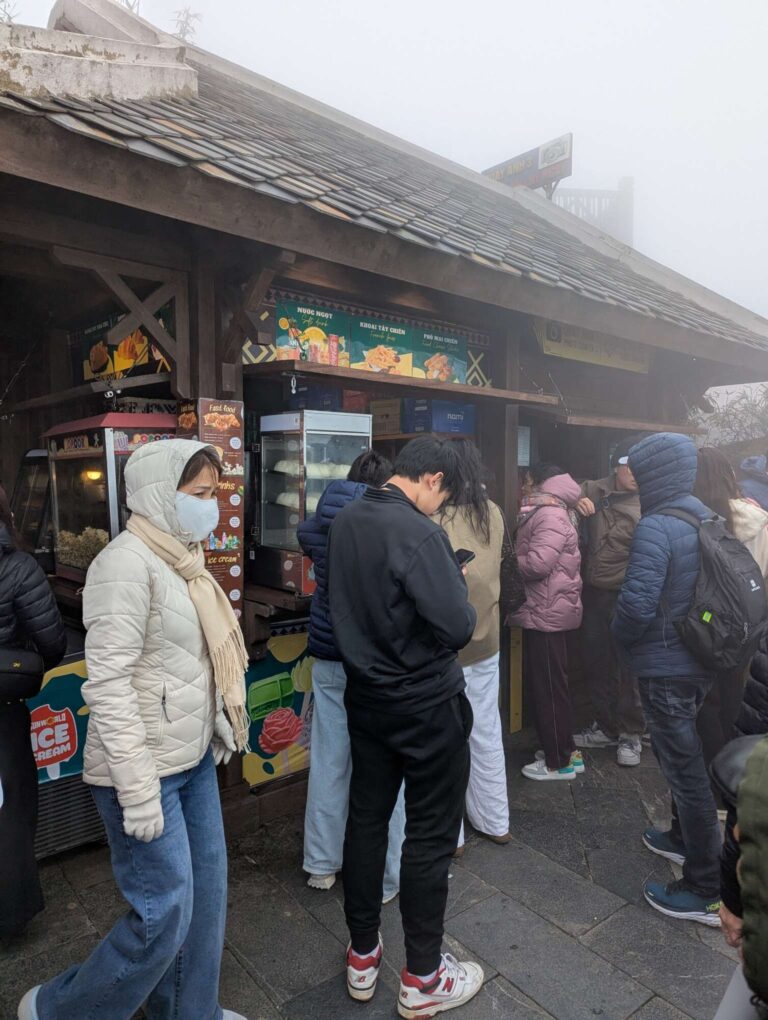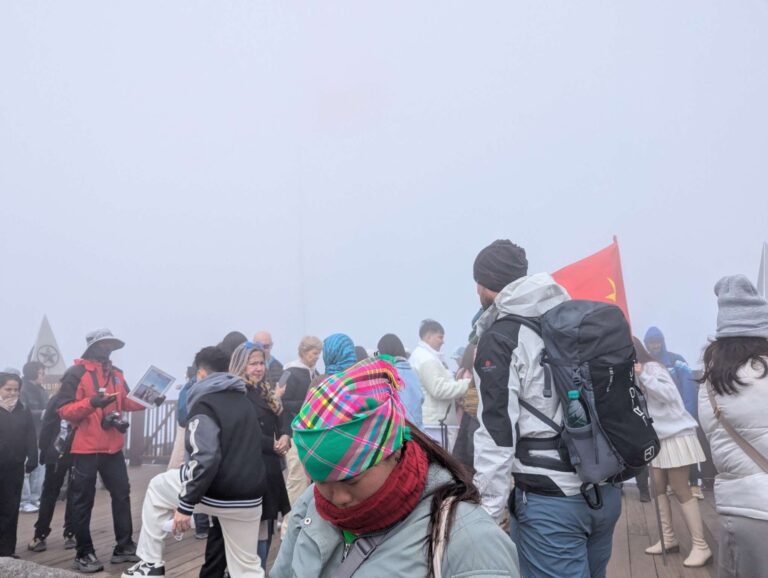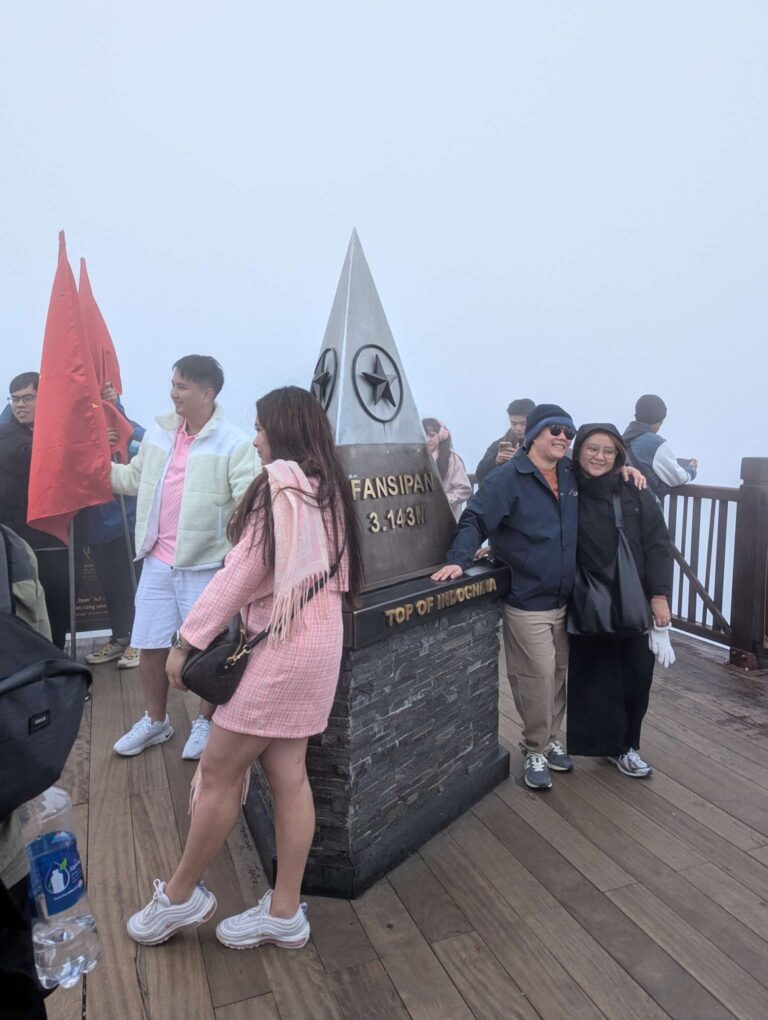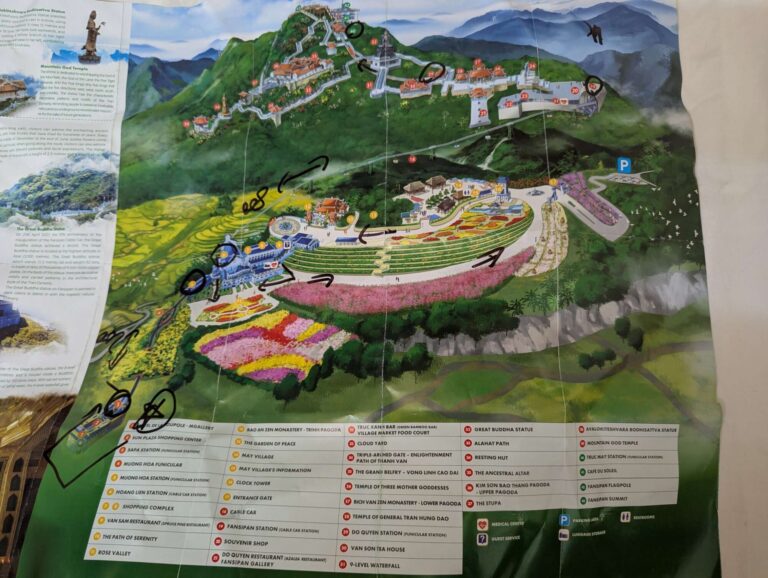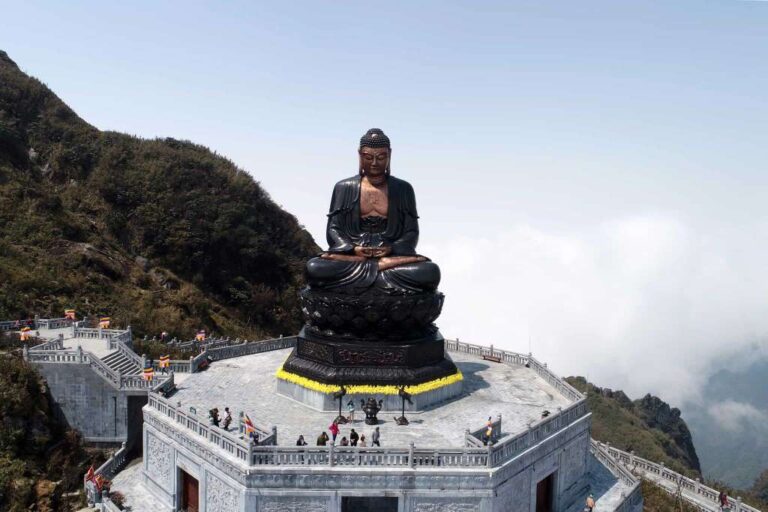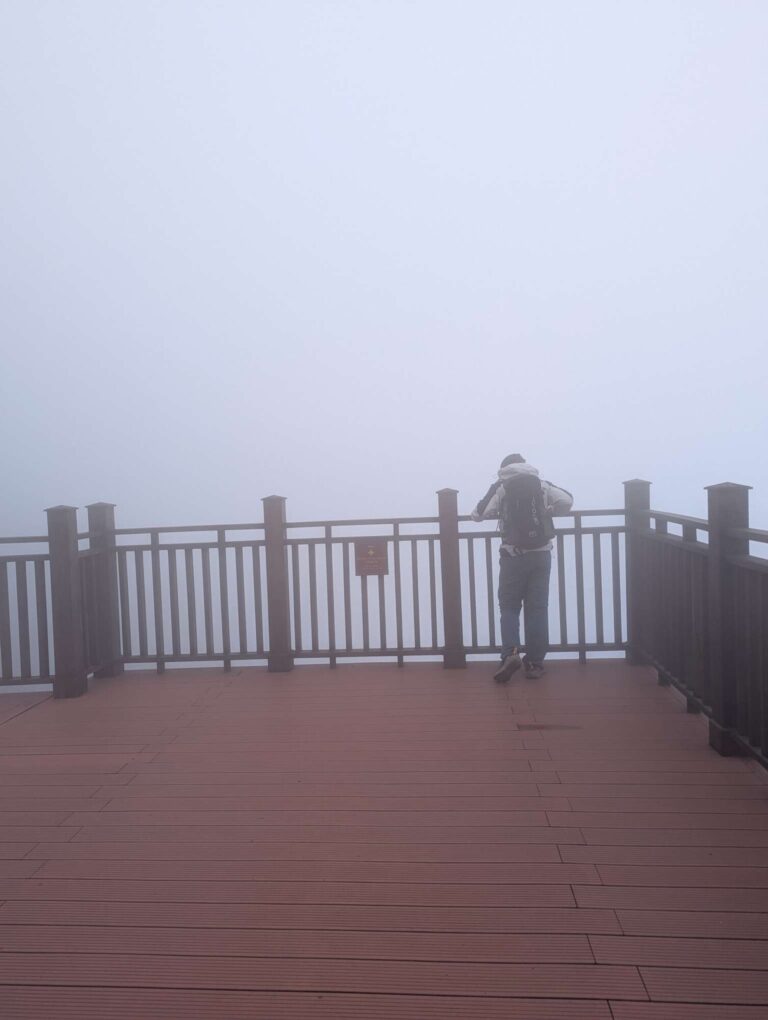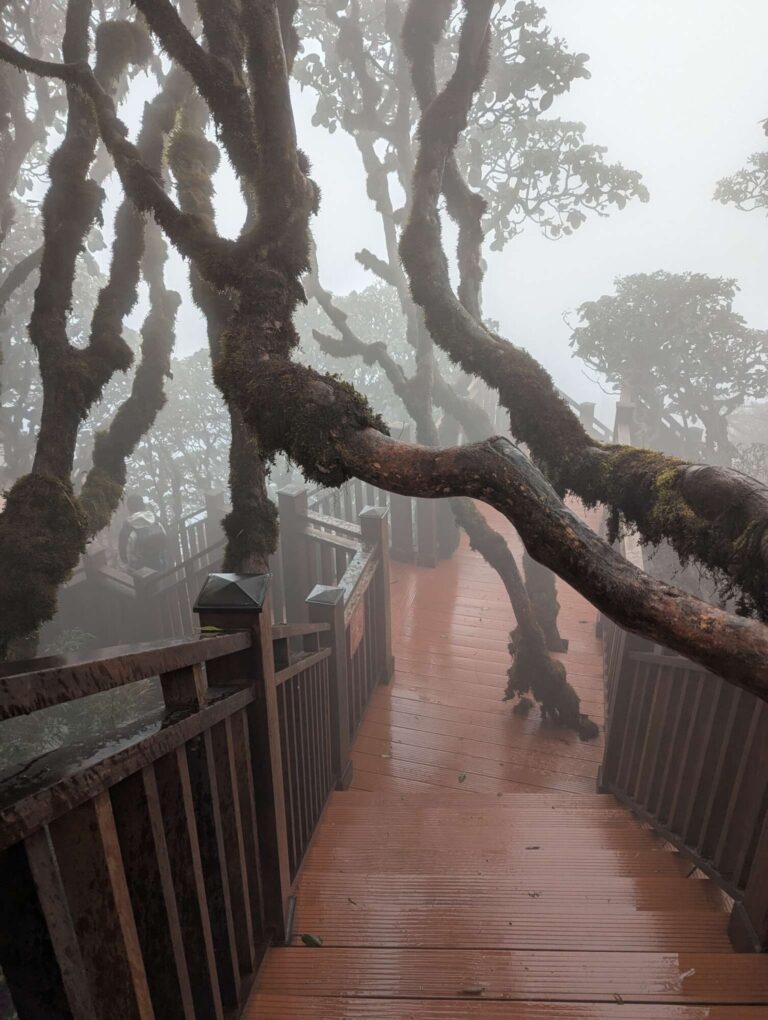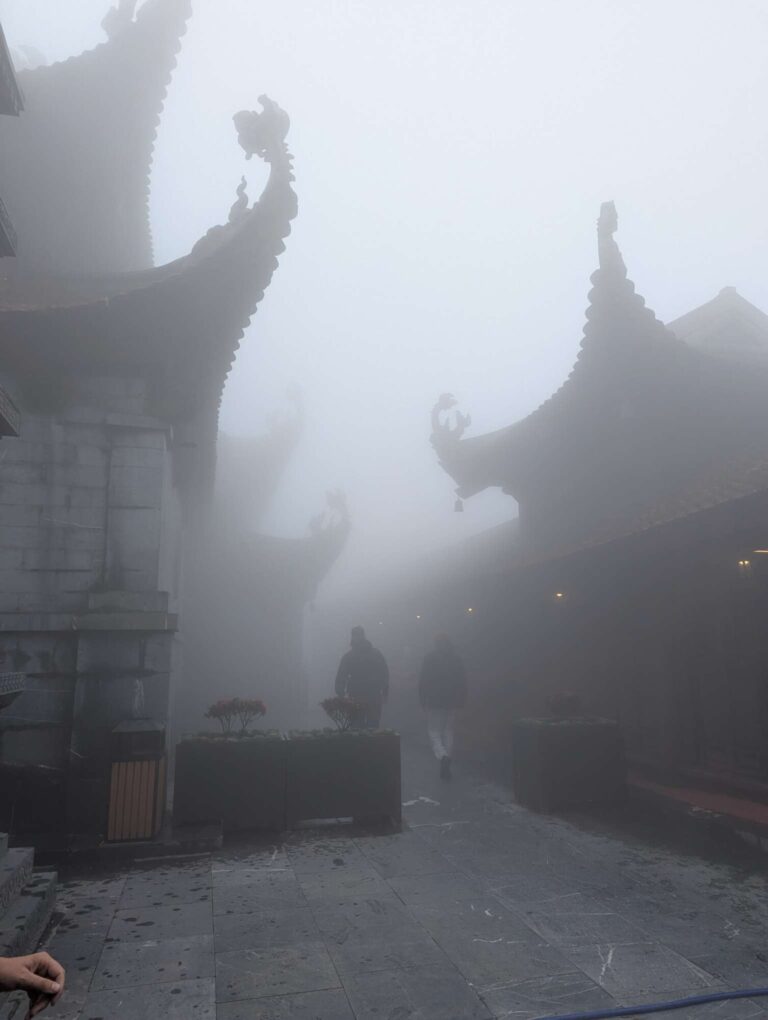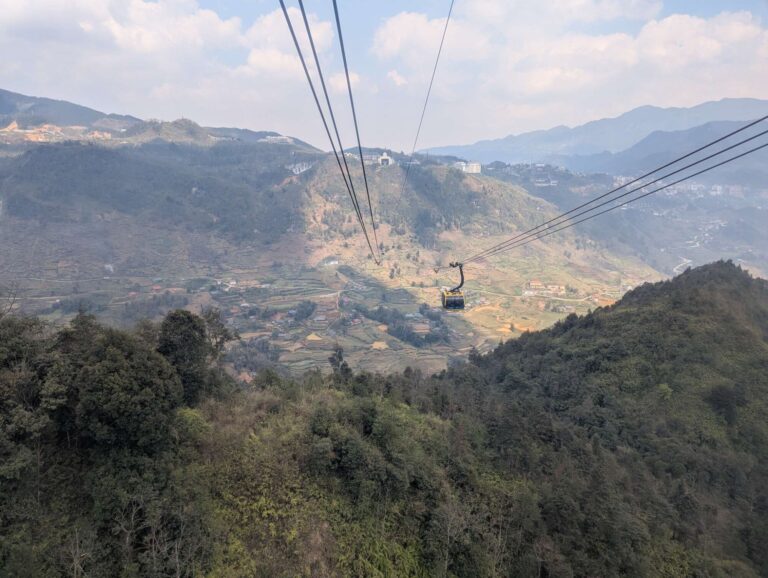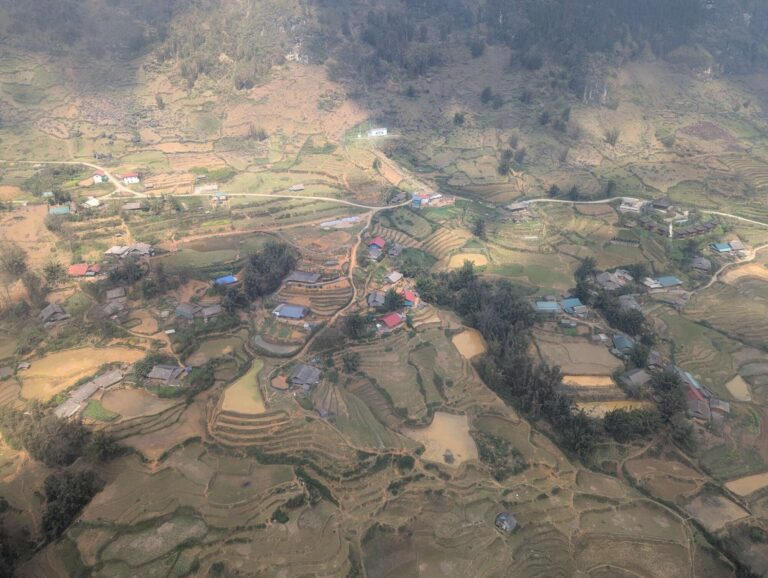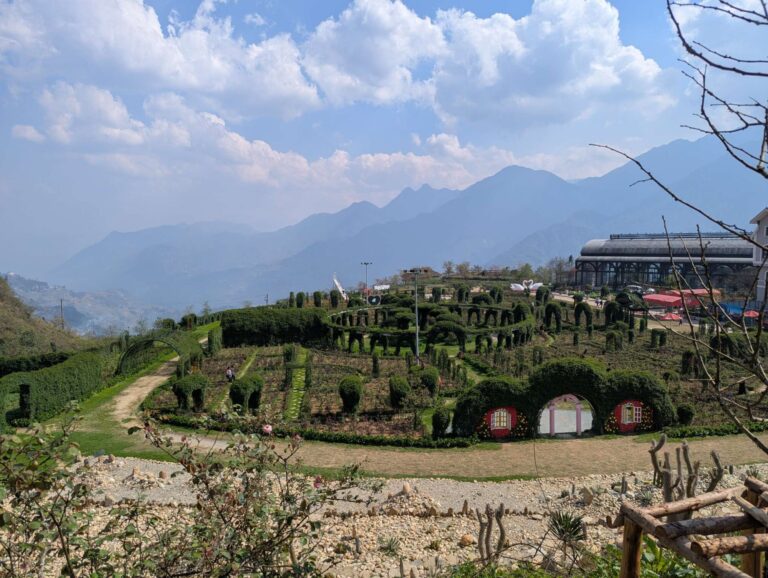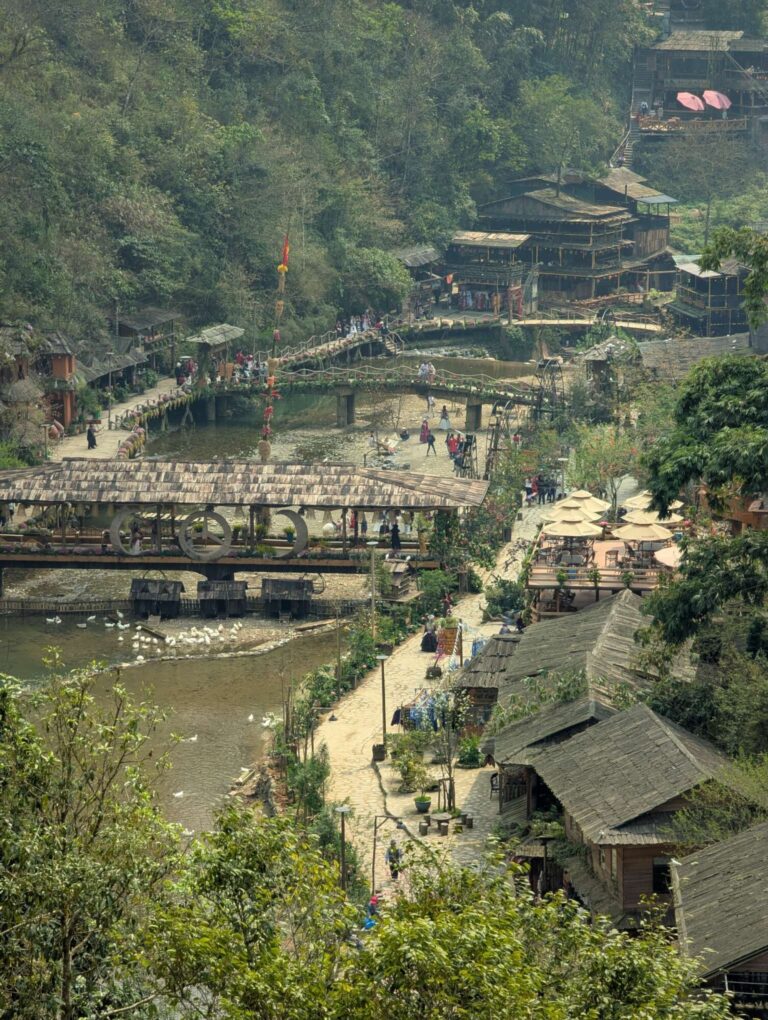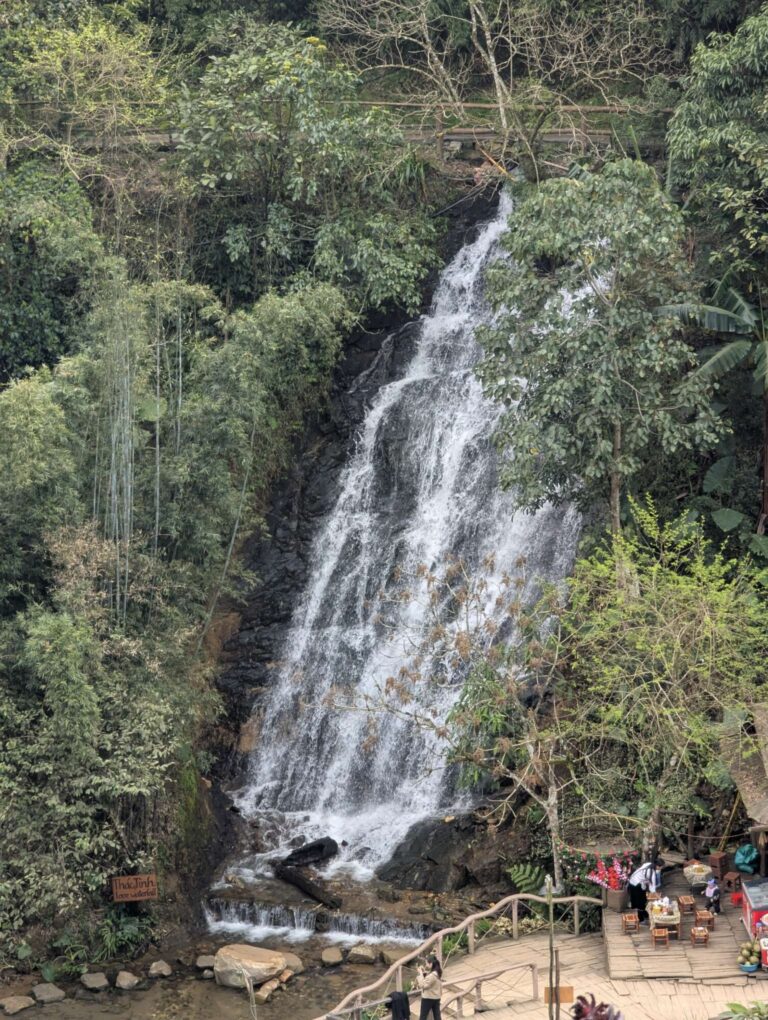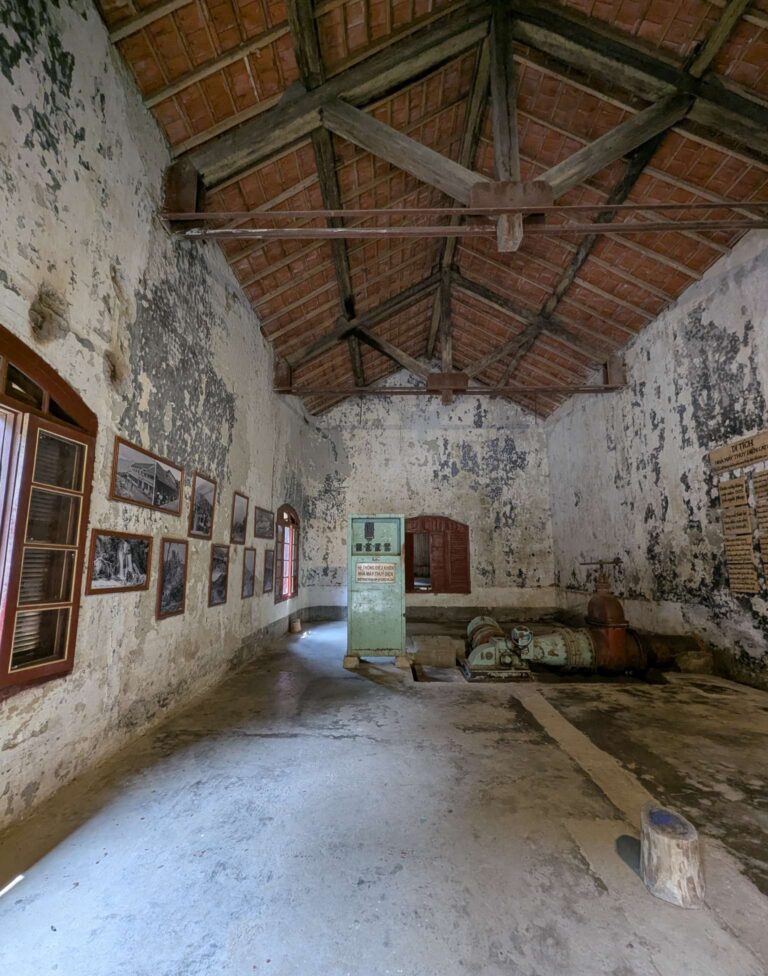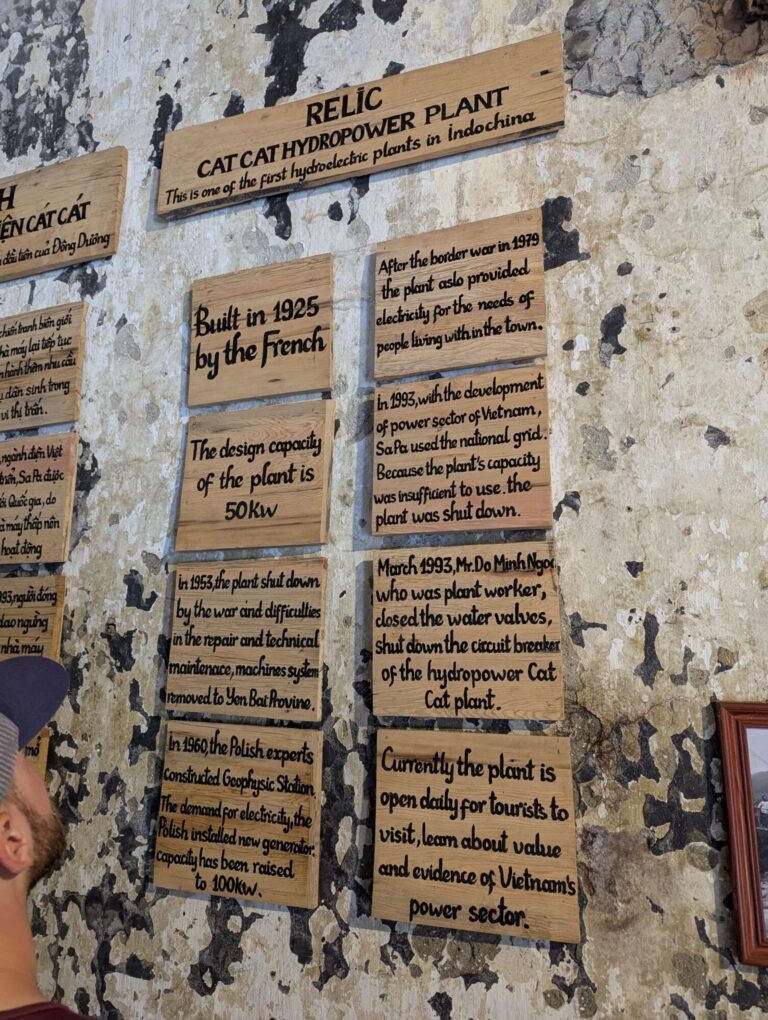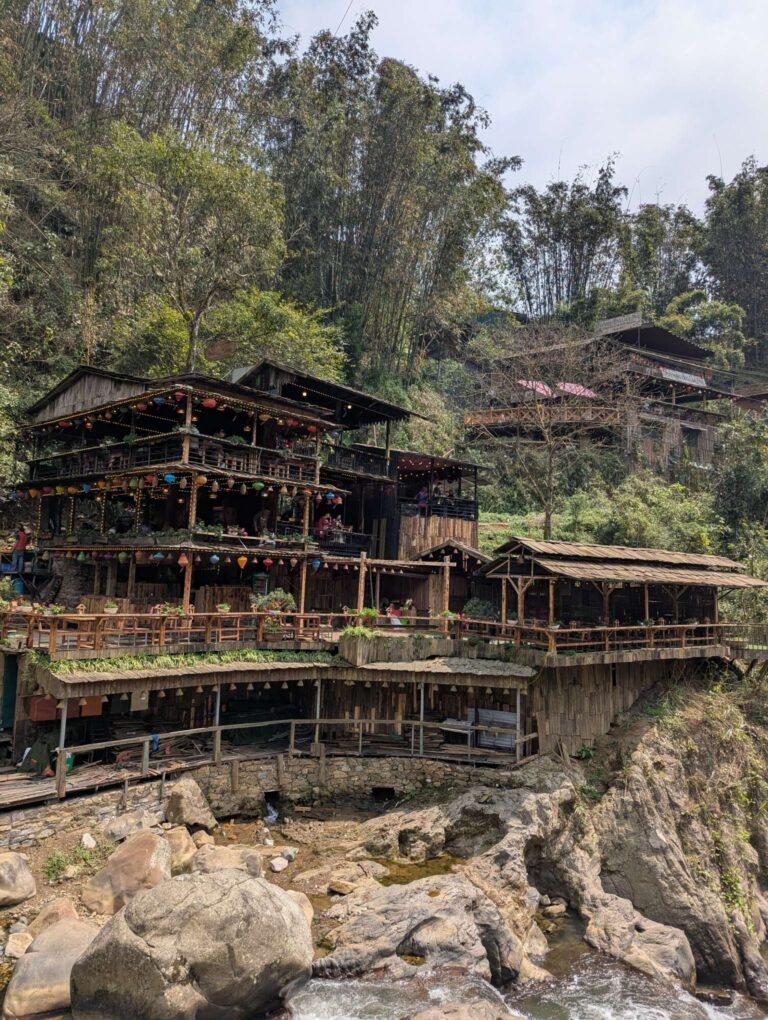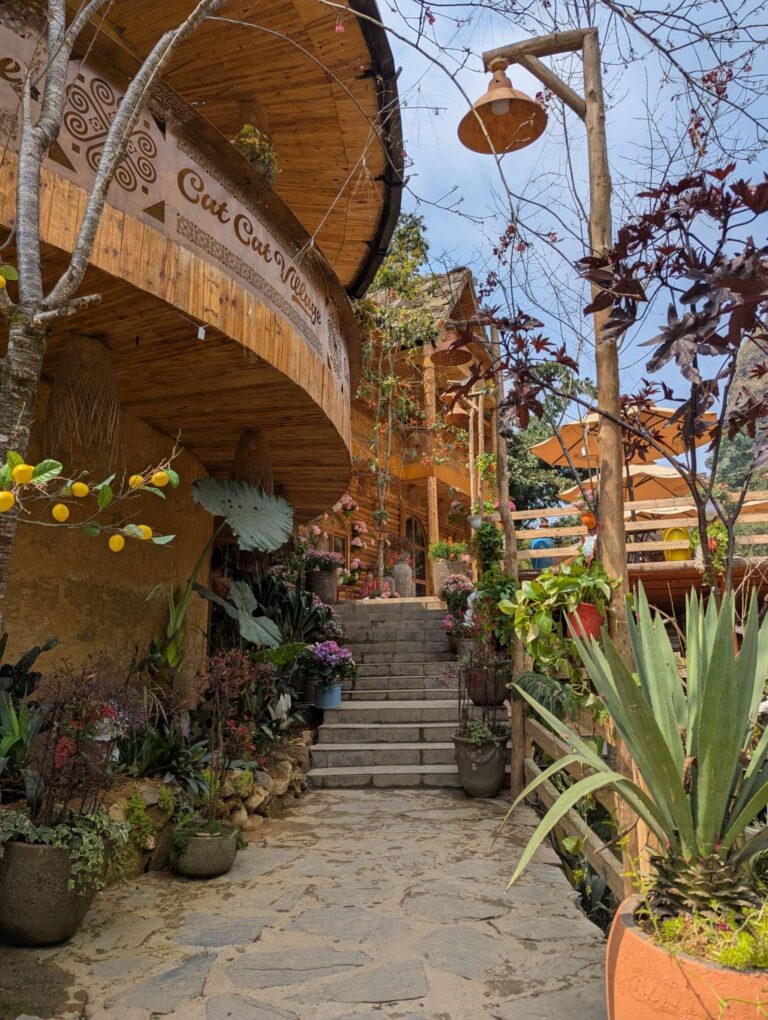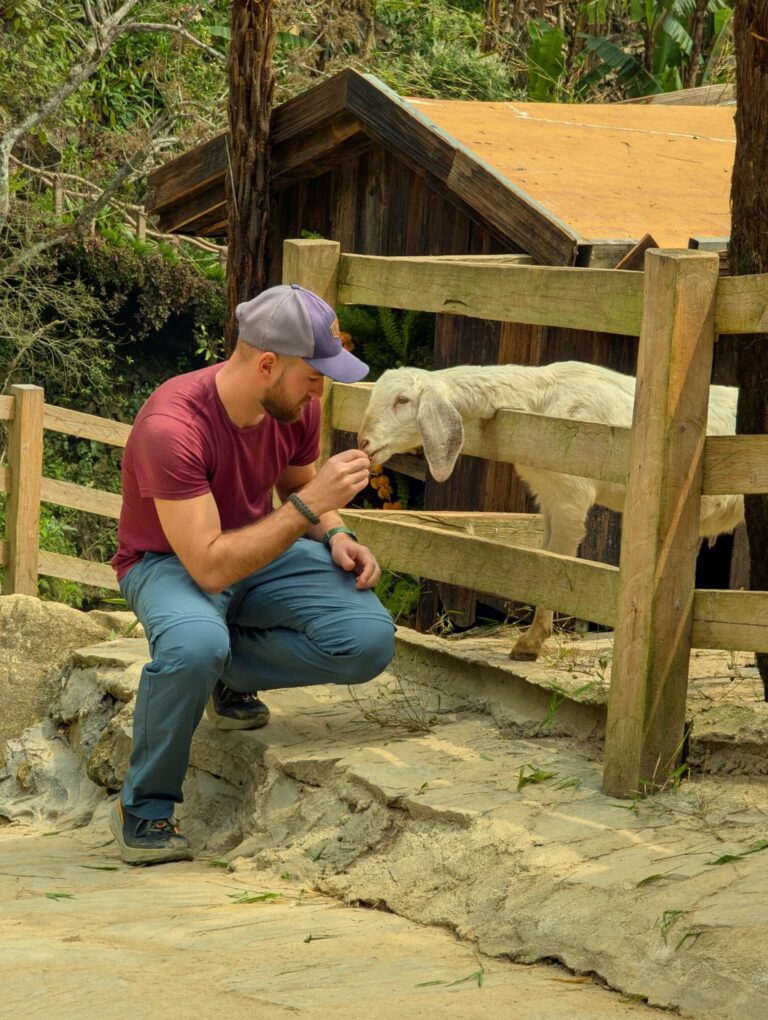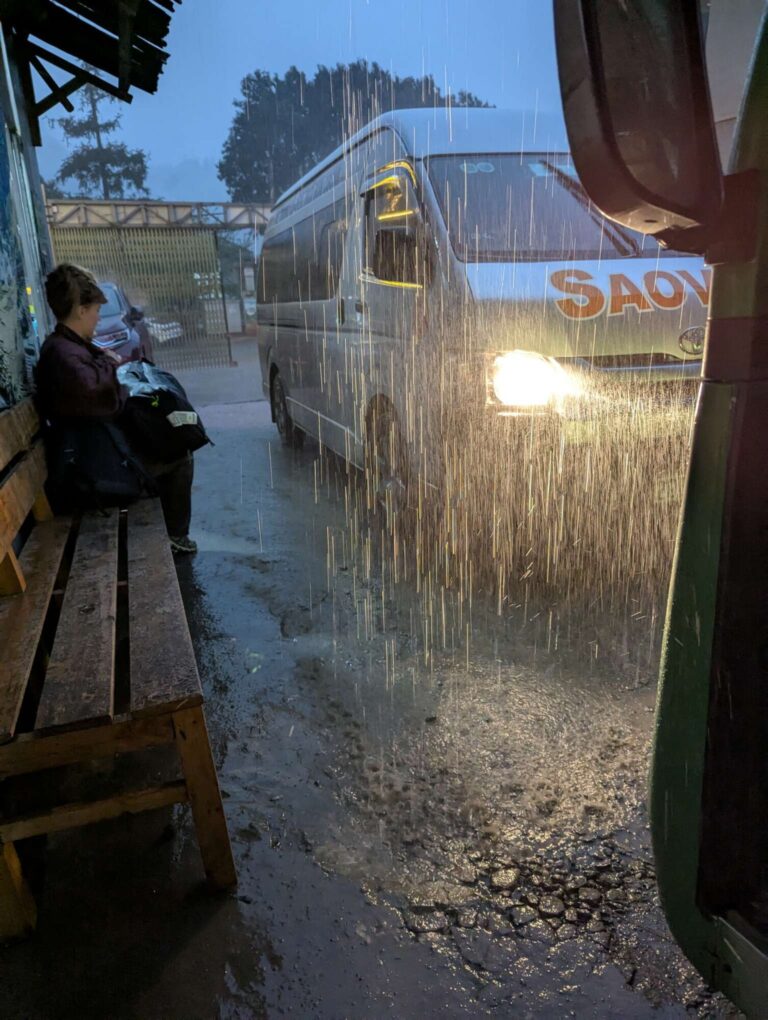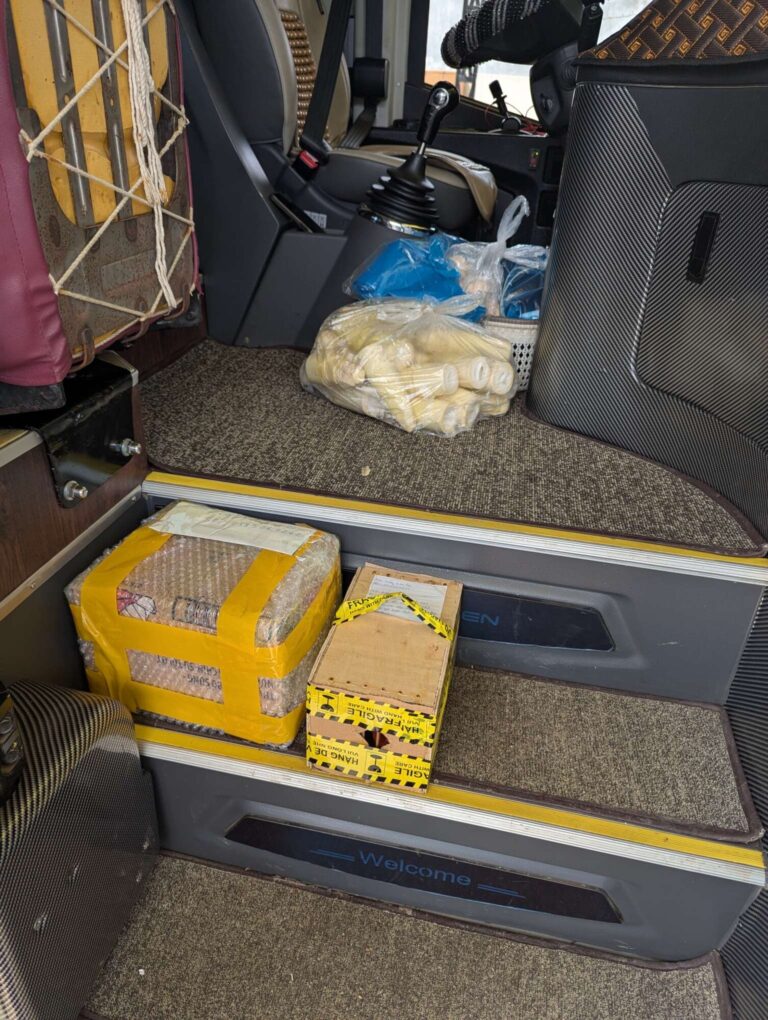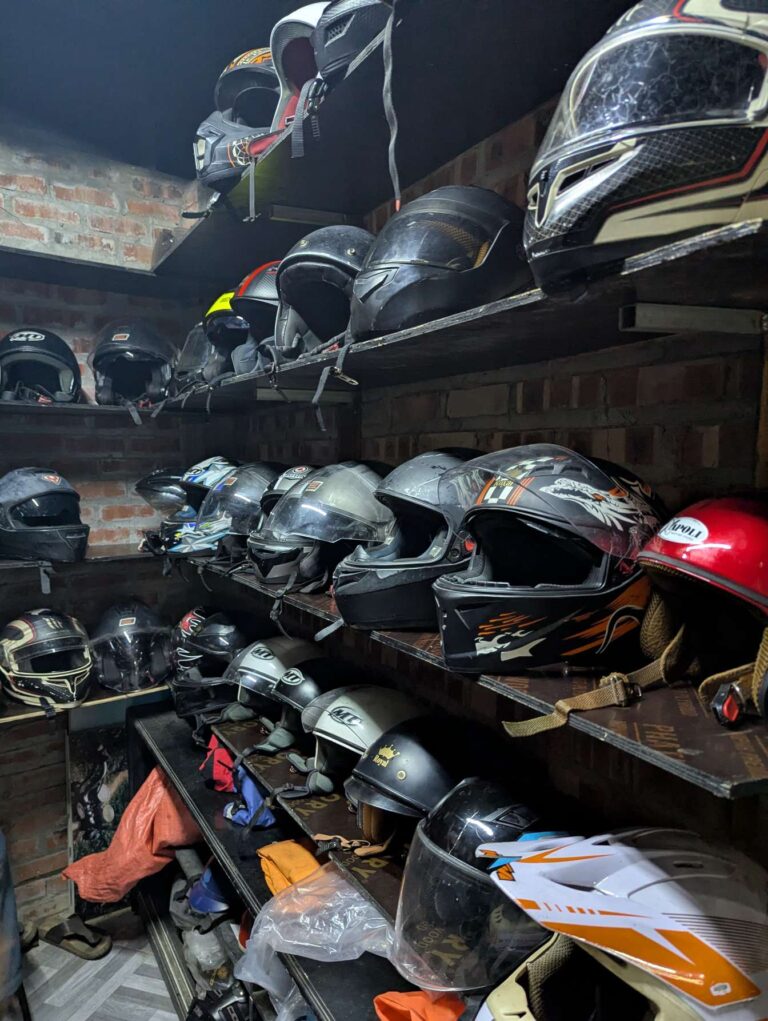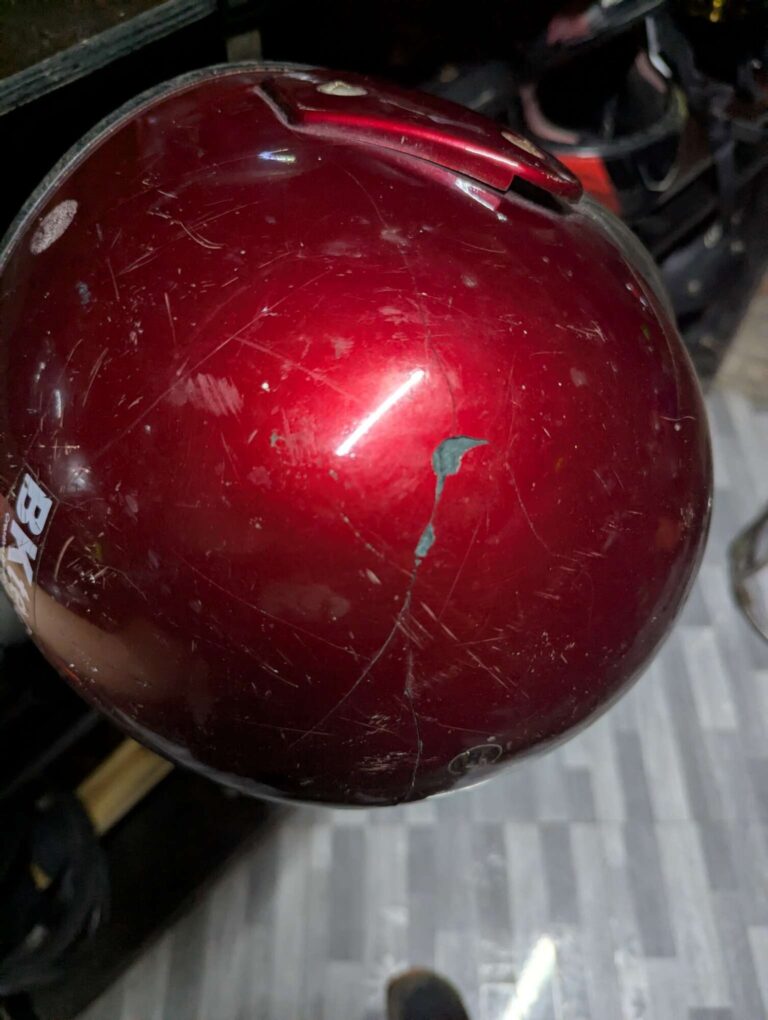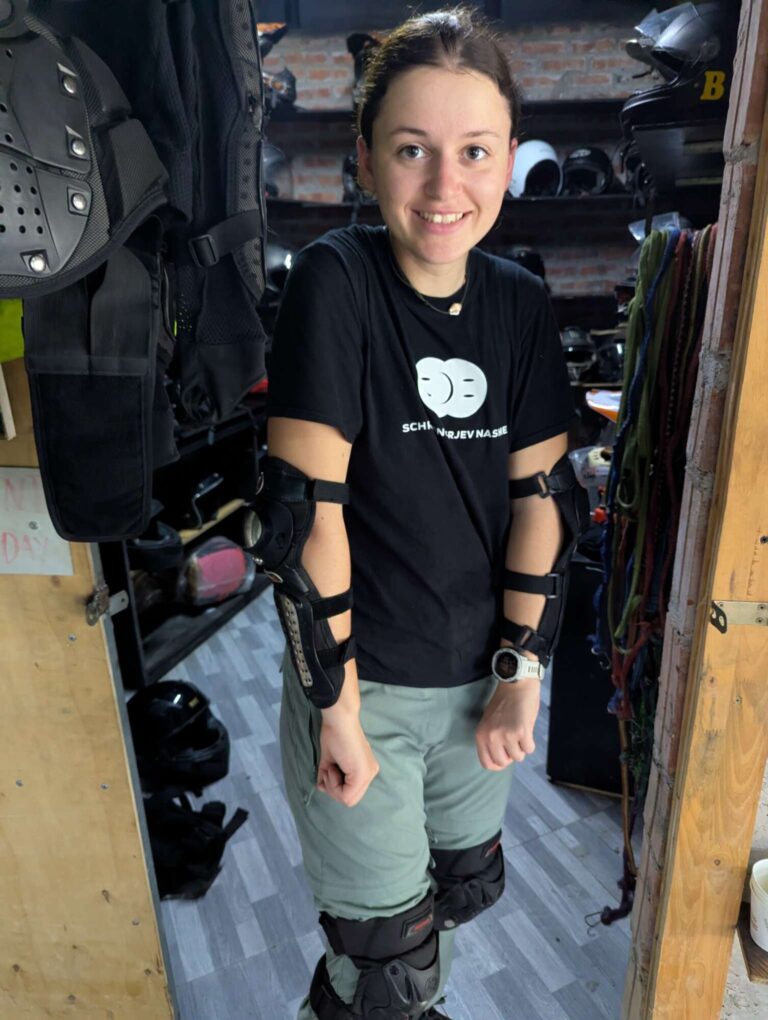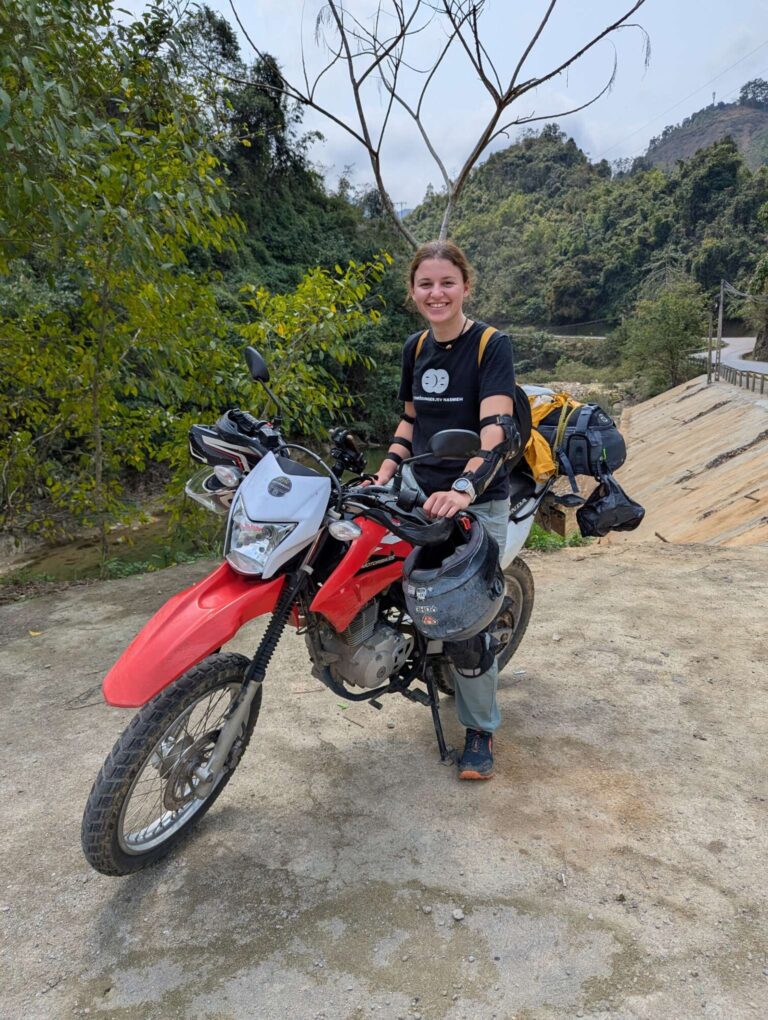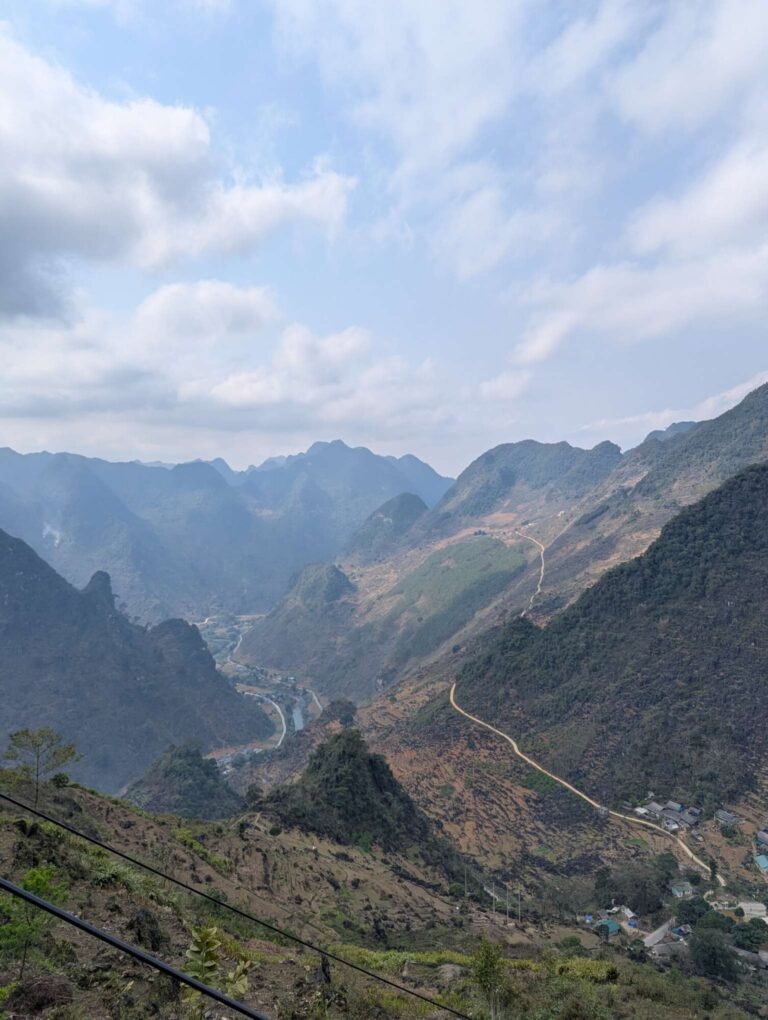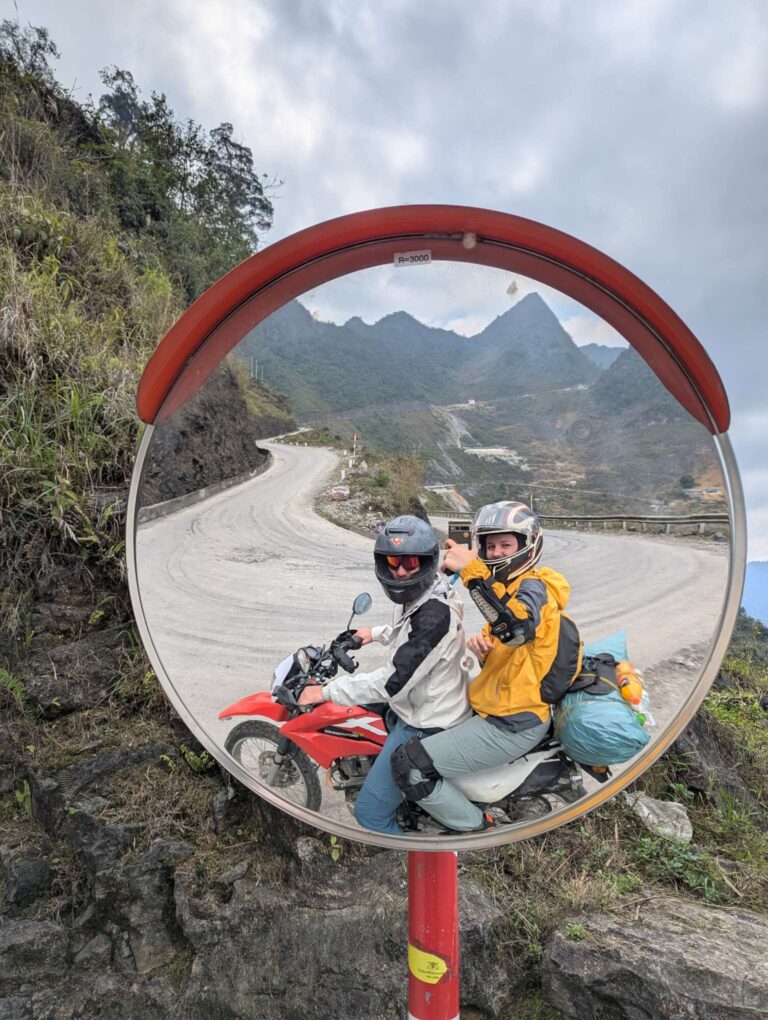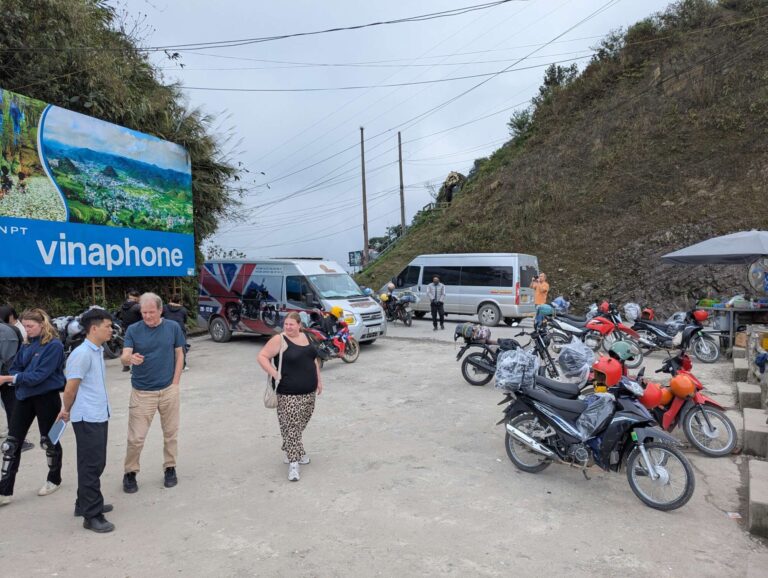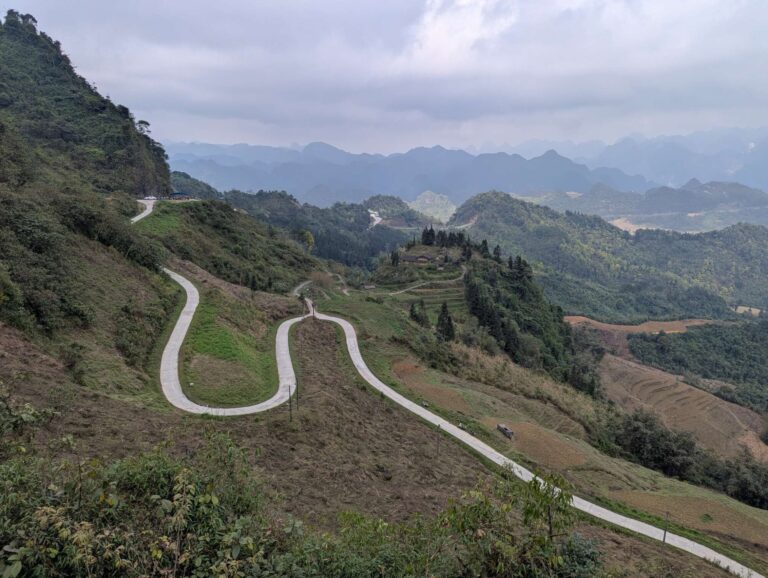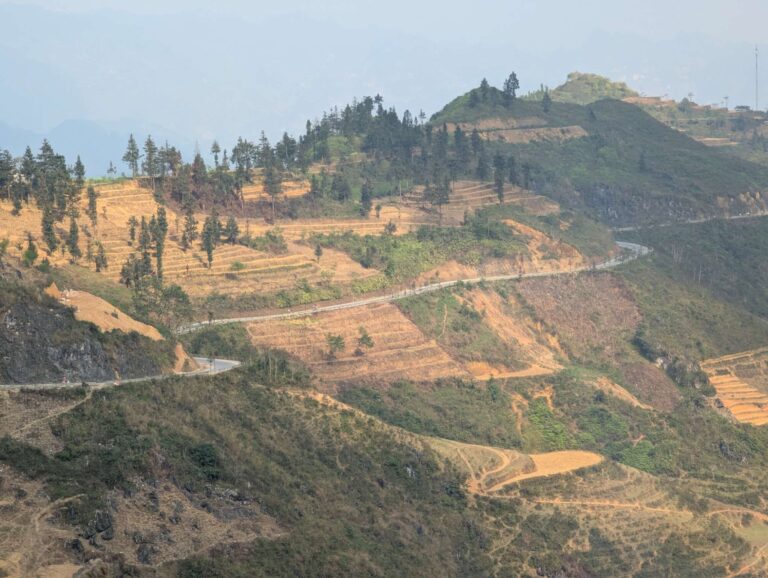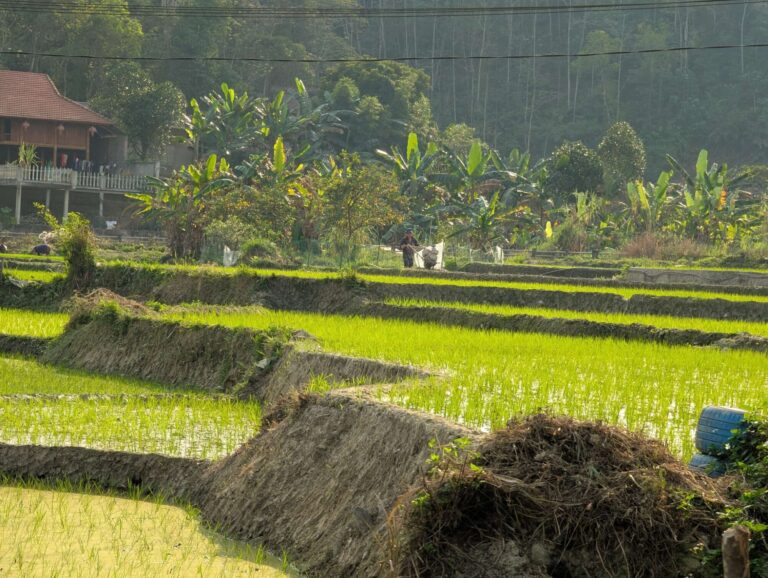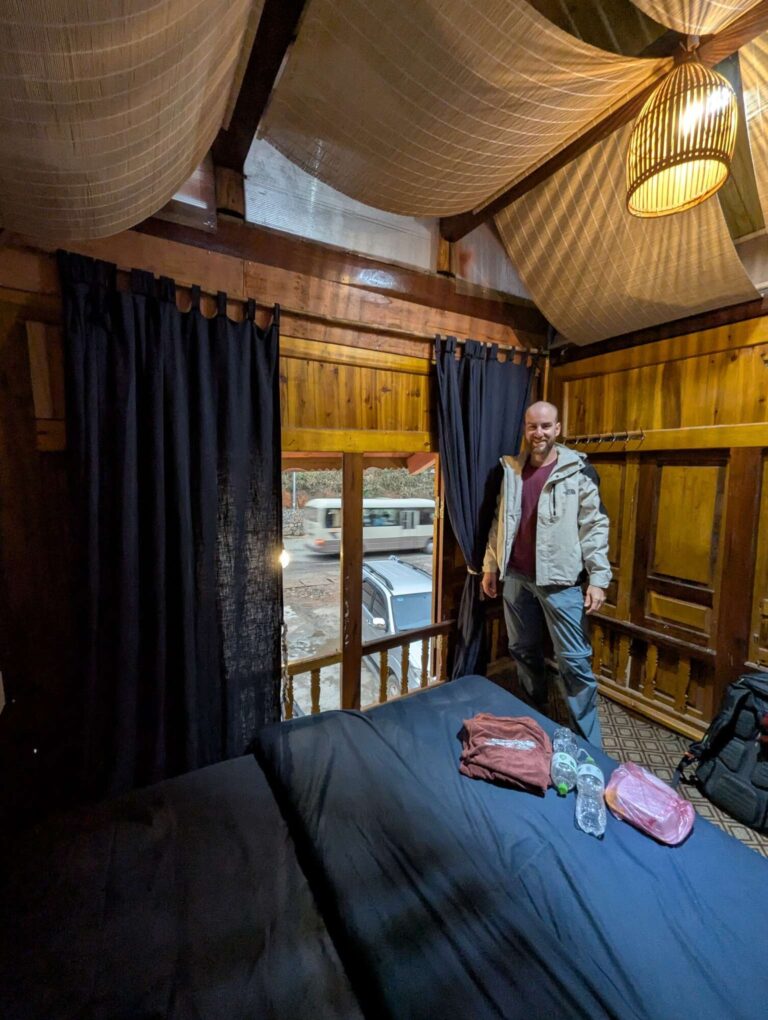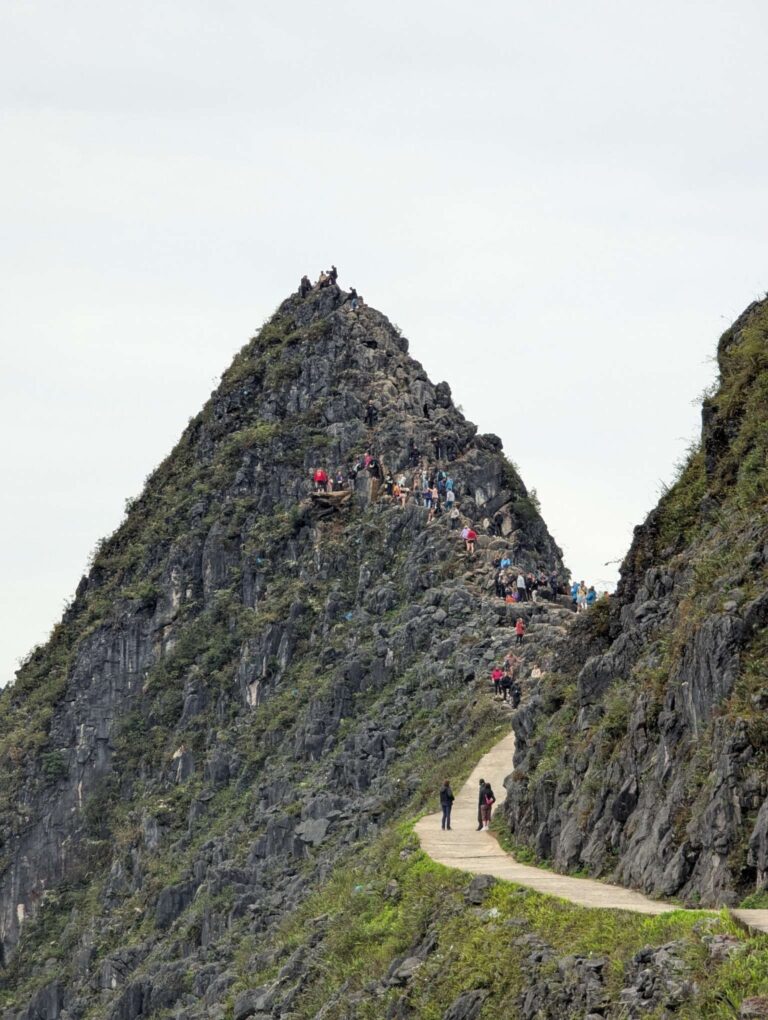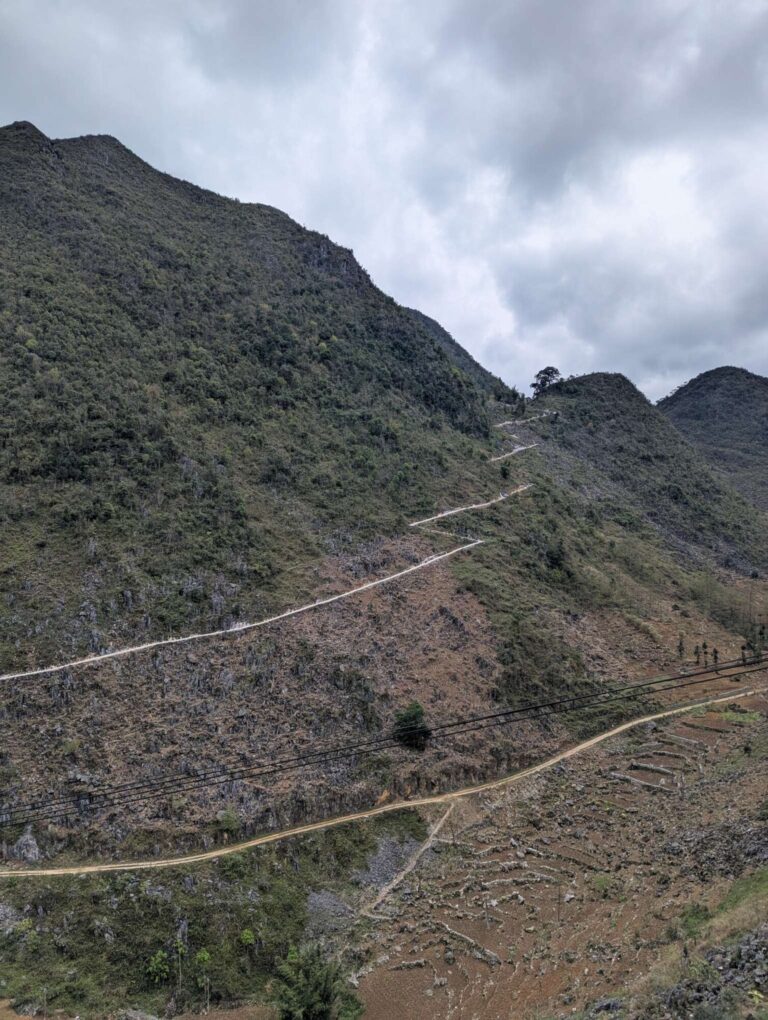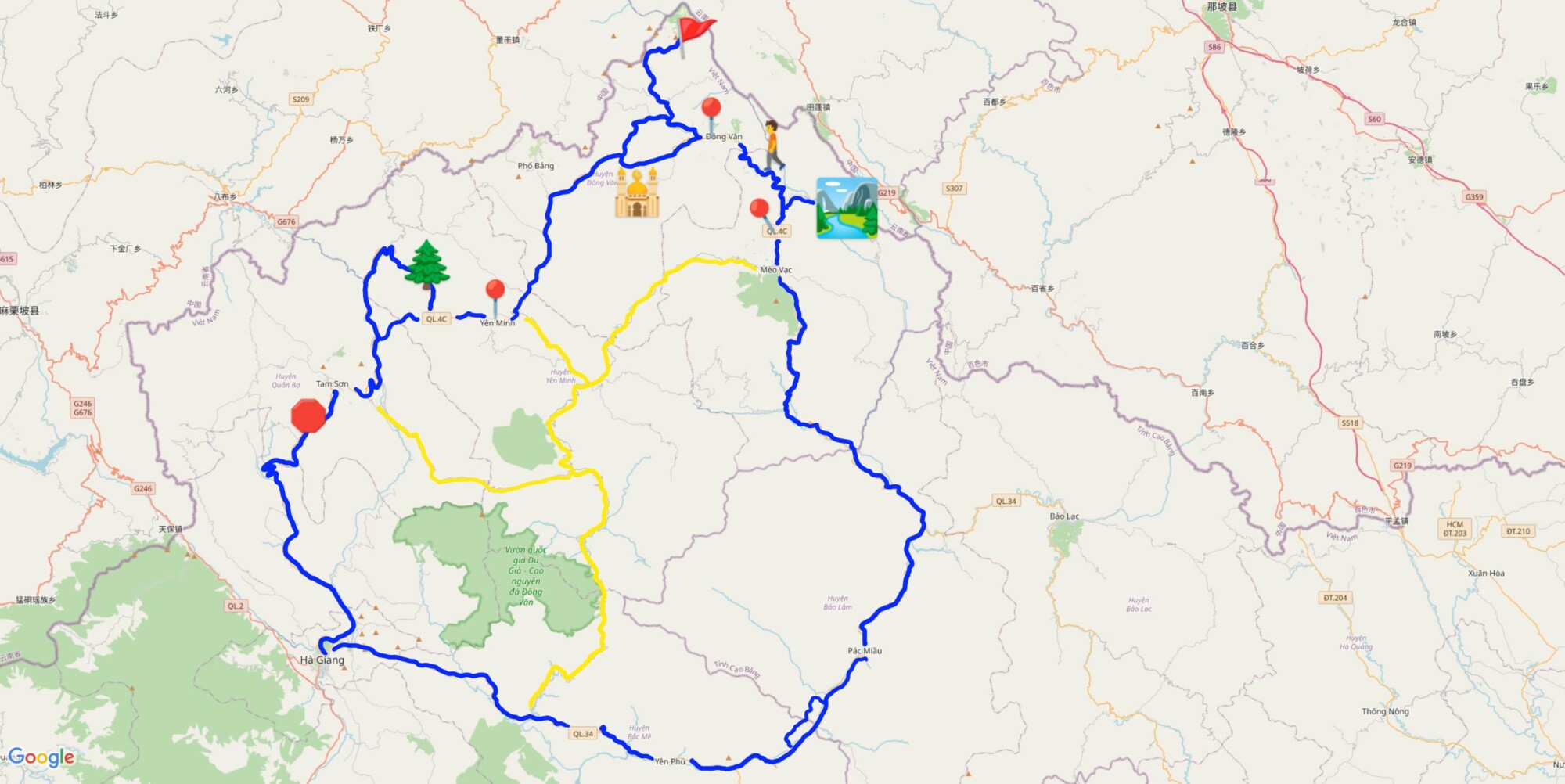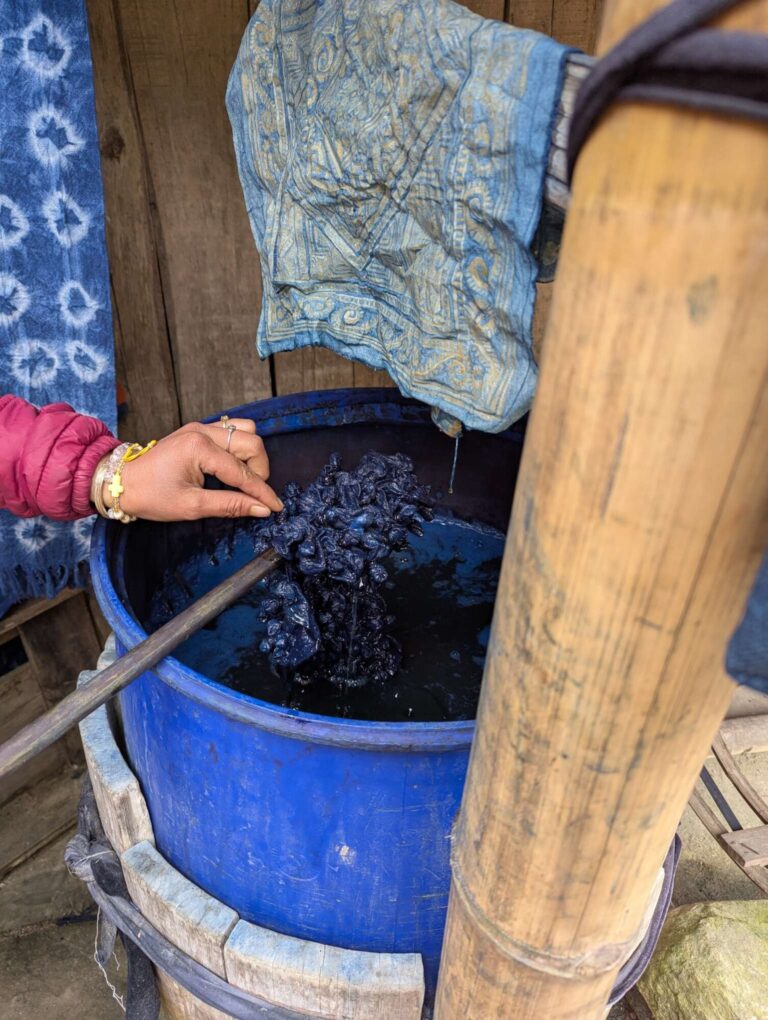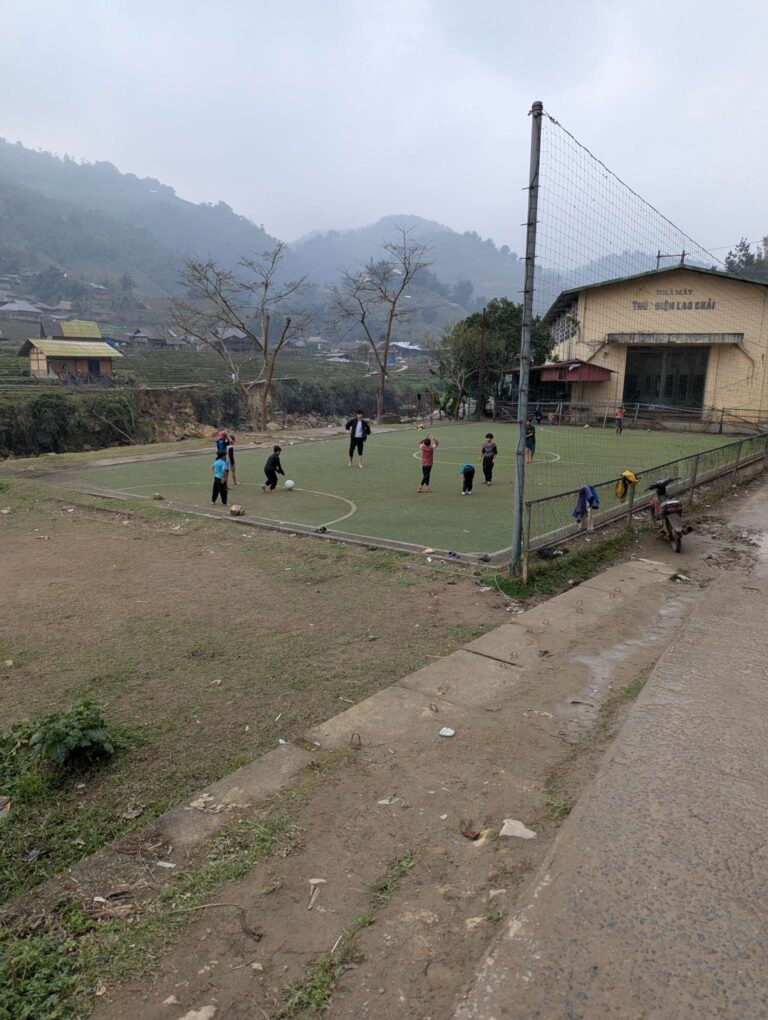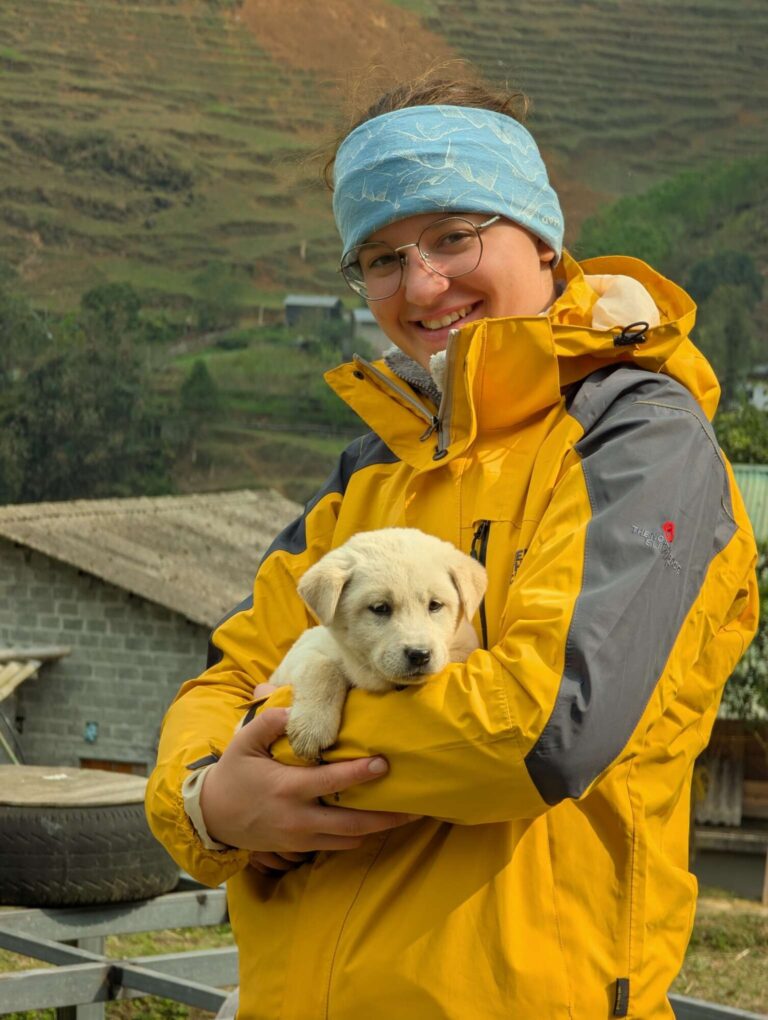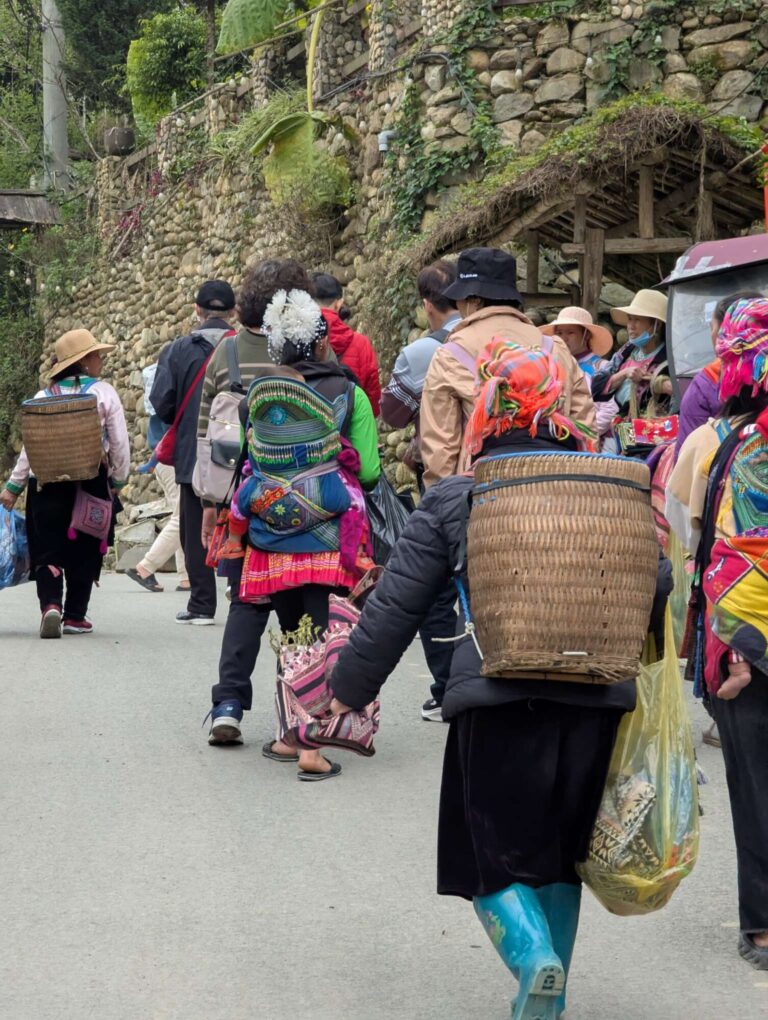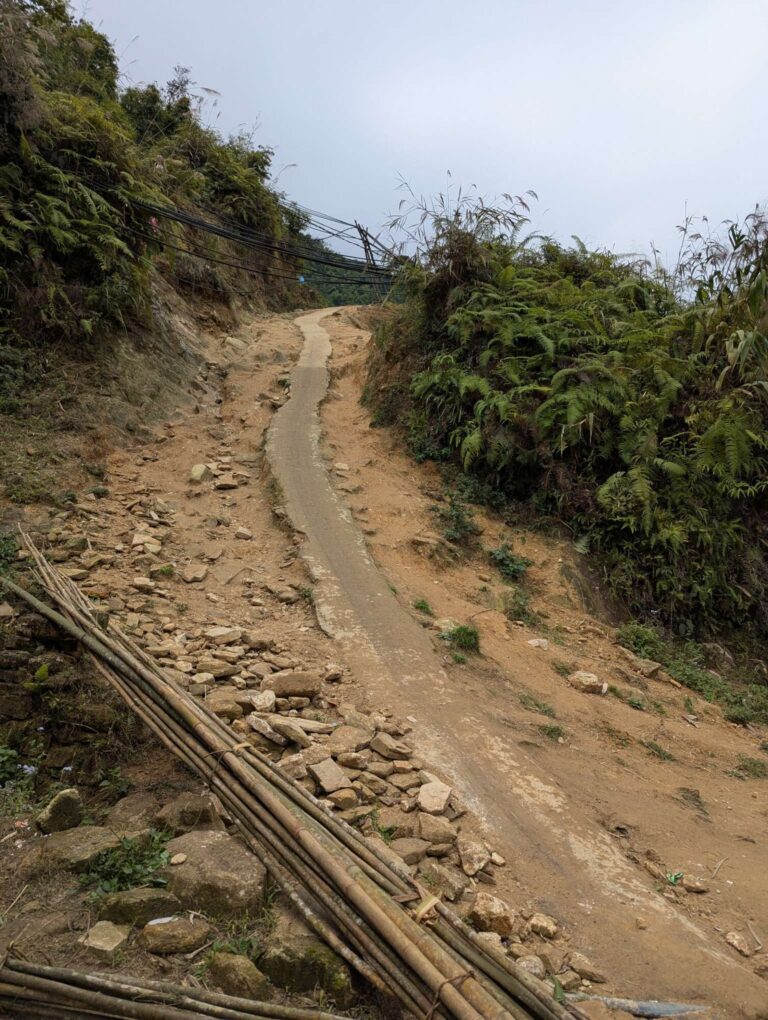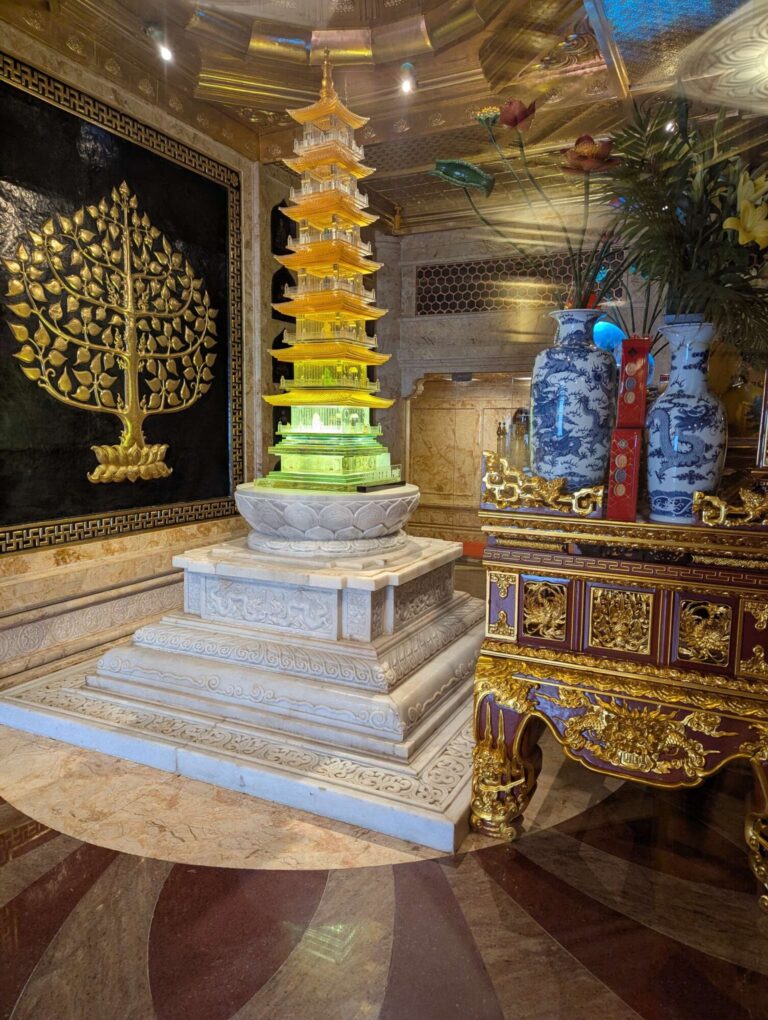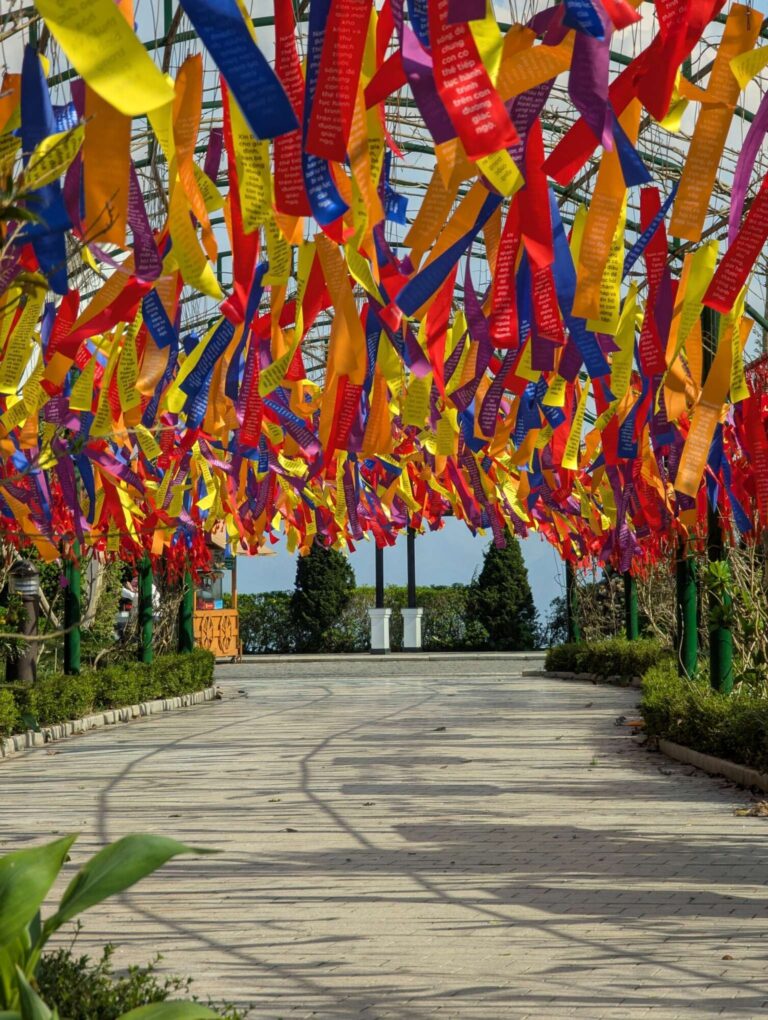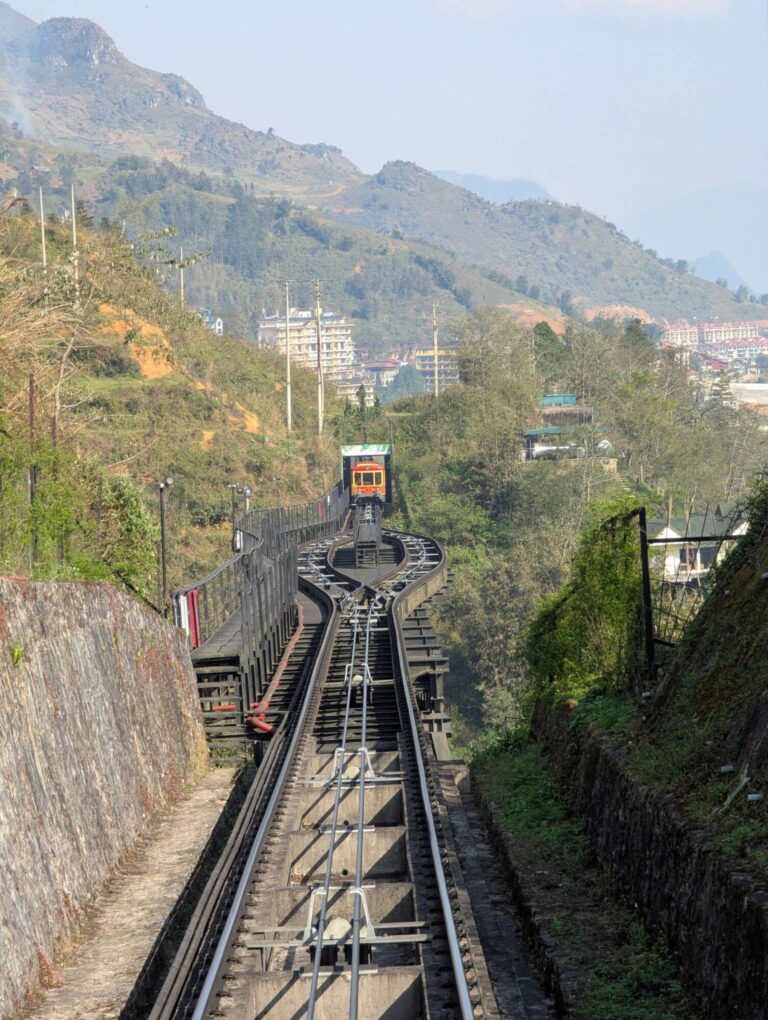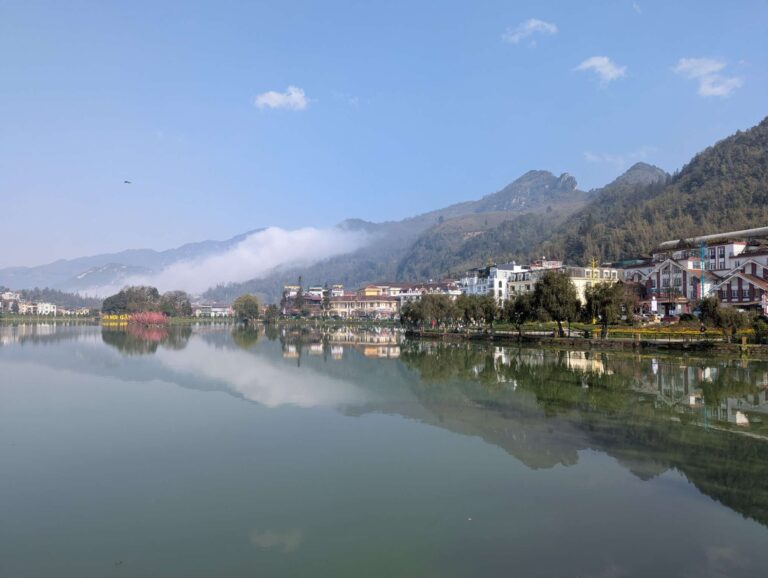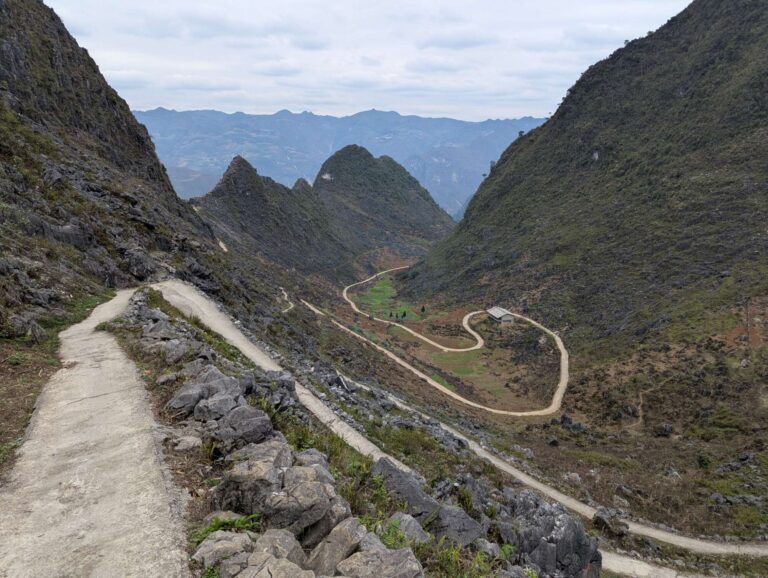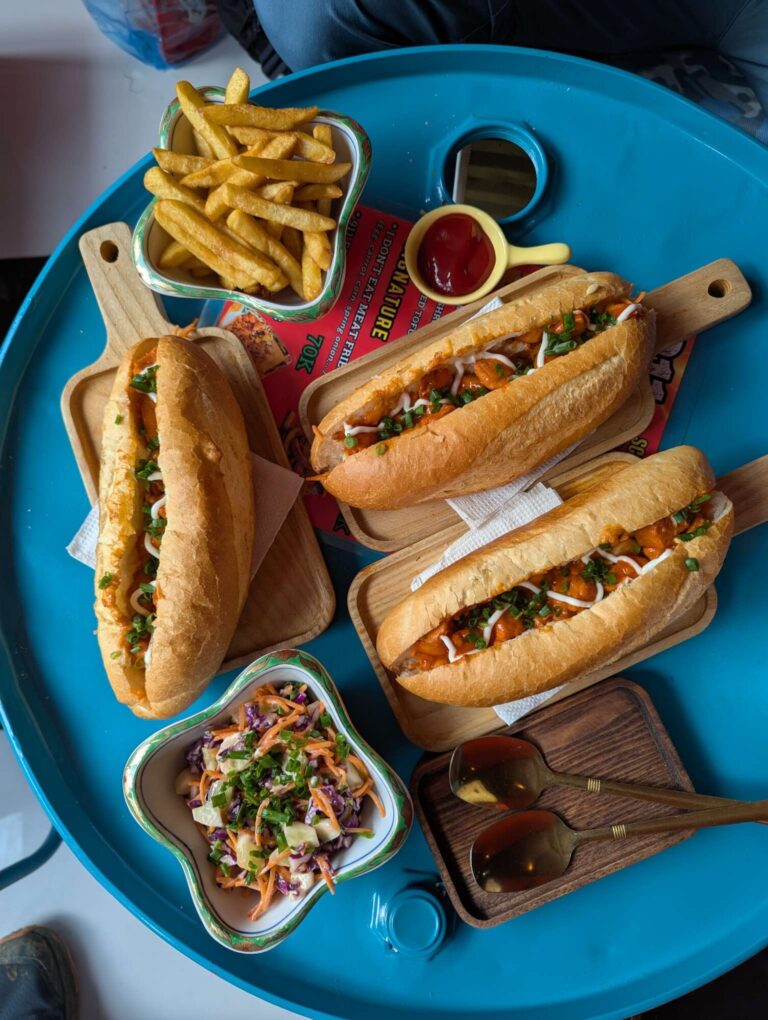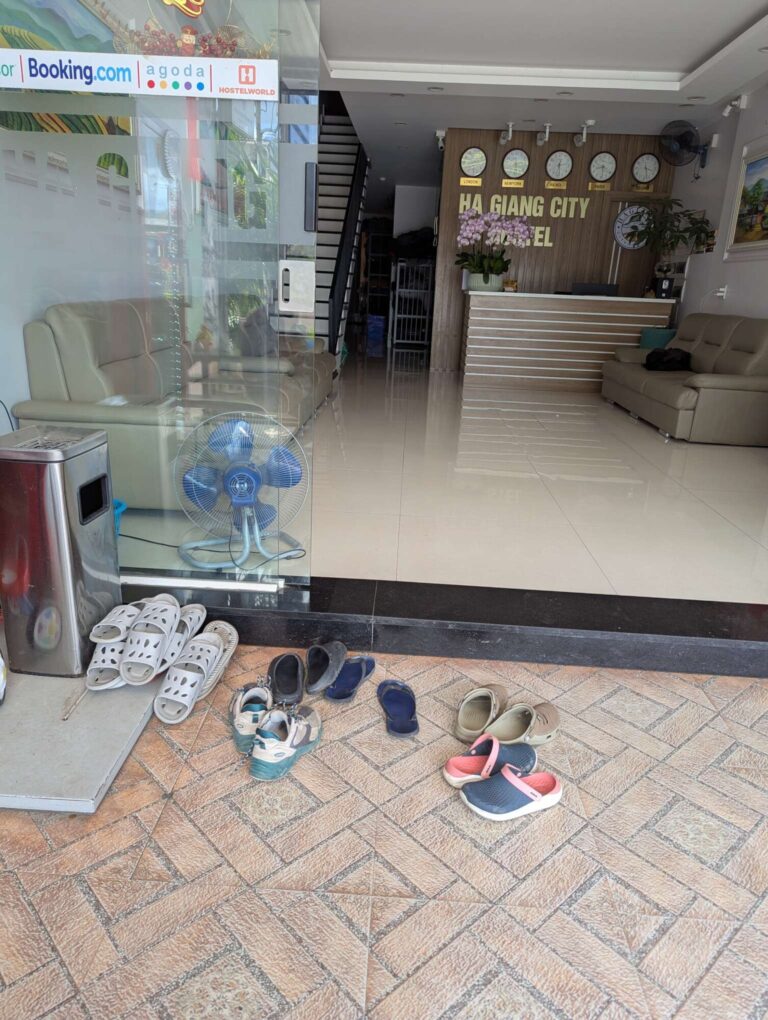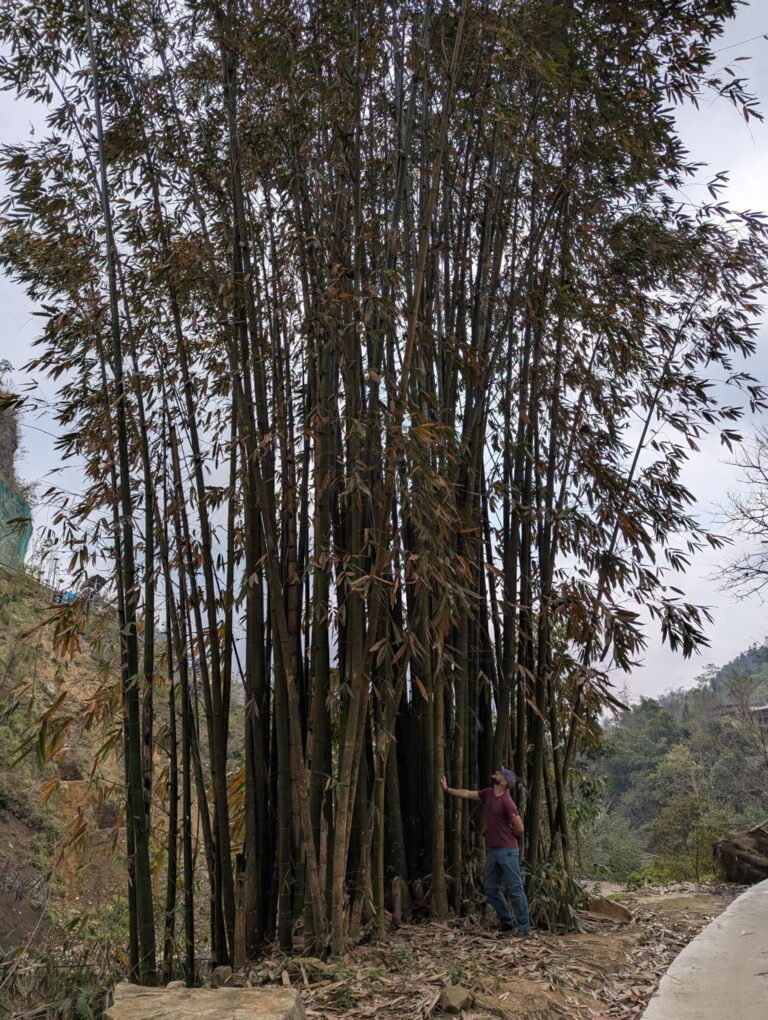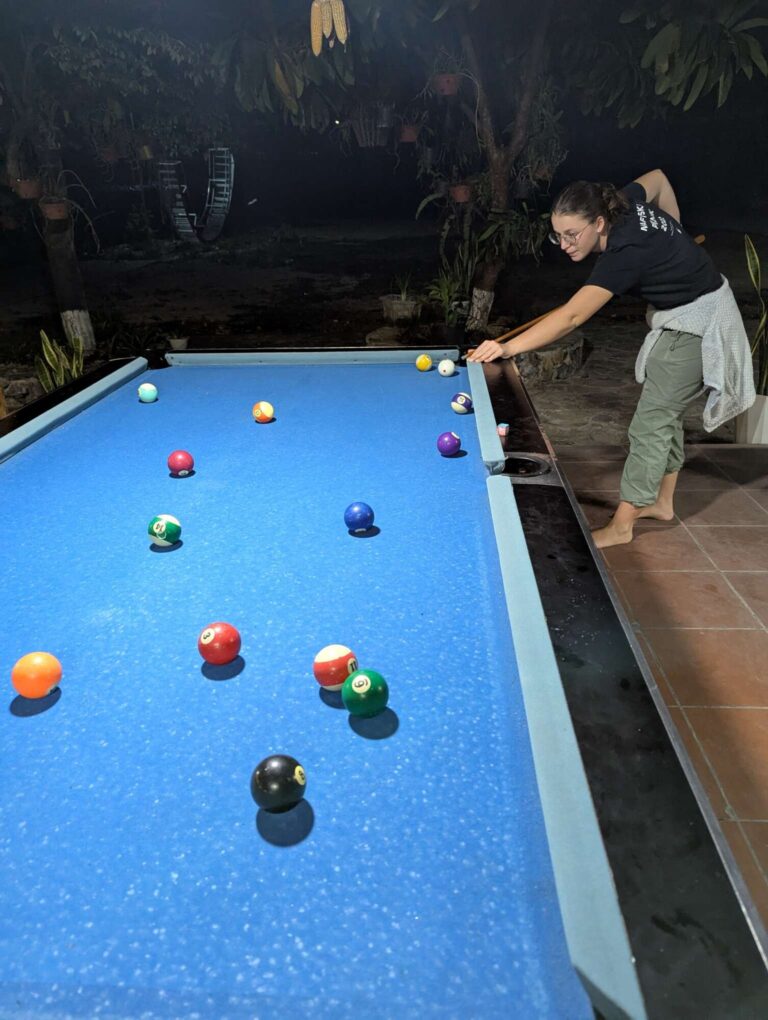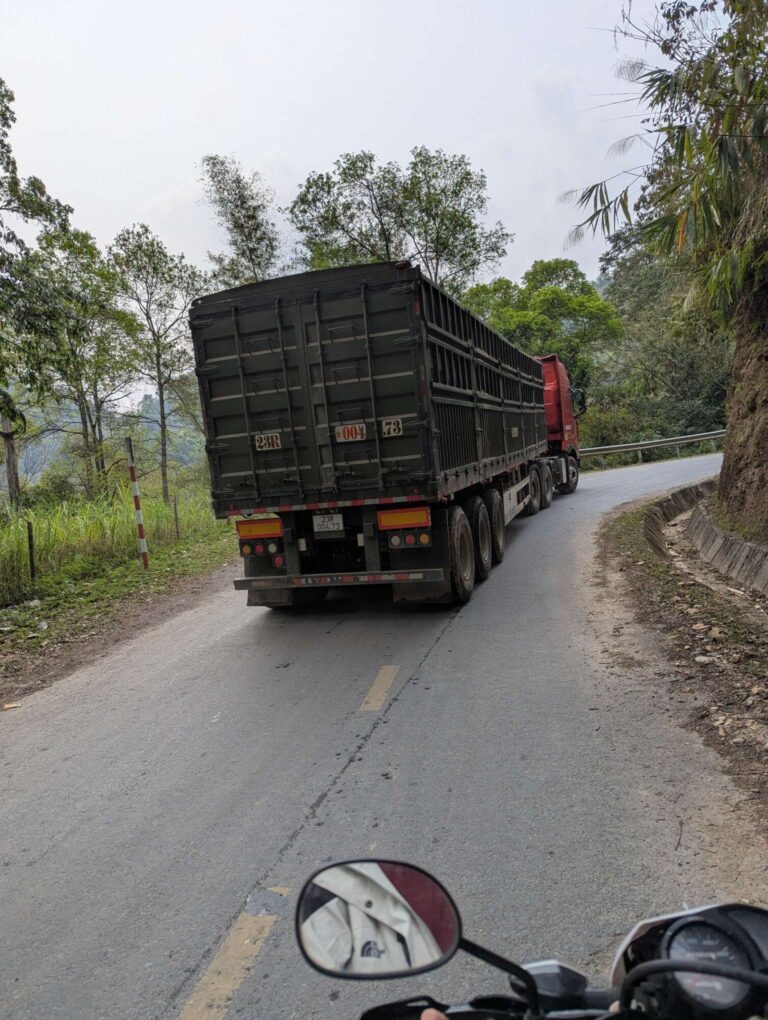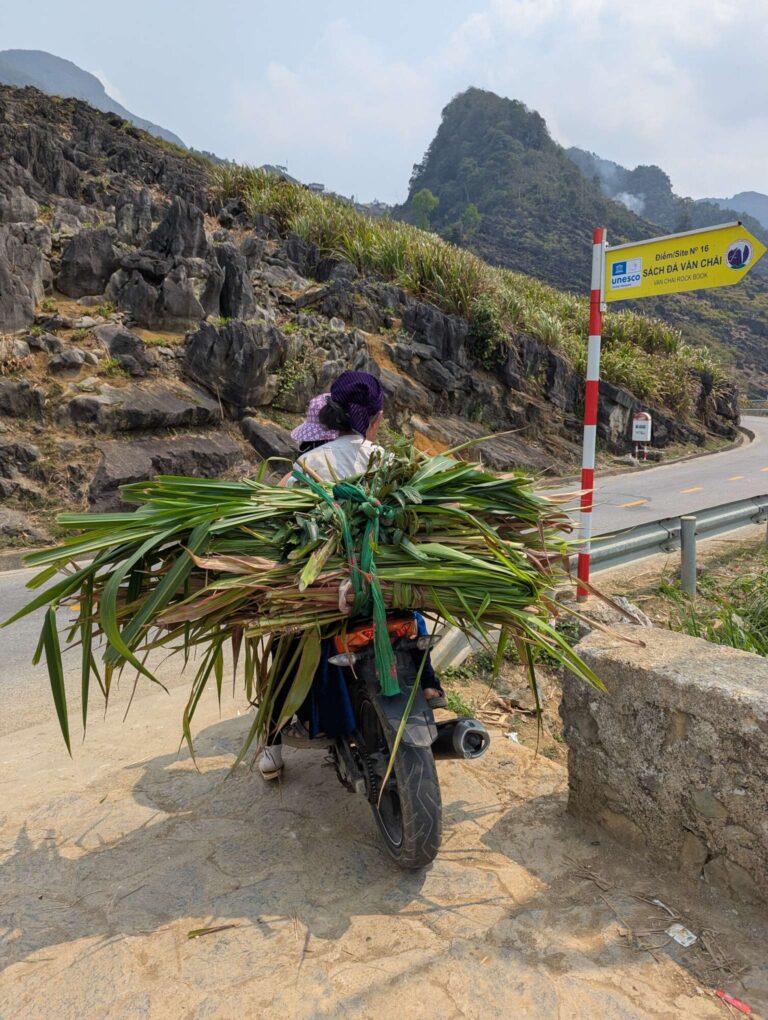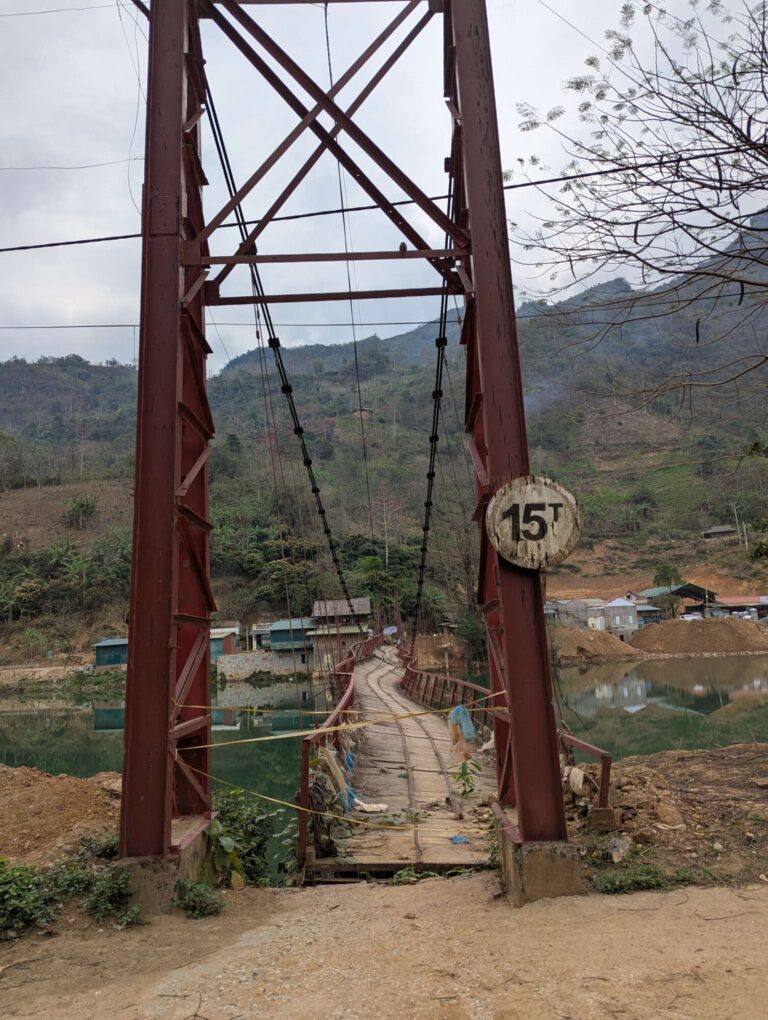Sunday, 9 March 2025 – Monday, 17 March 2025
VIP sleeper bus from Hanoi to Sapa—this is where we woke up on Sunday, day 7. But it wasn’t morning yet; it was barely over midnight; time for the second break on our ride. We had no idea where we were; all we could see was a small covered market area with most of the stalls empty. There was a toilet available for a 0.12€ fee. We both had a restless night, waking up multiple times even though sleeping on the bus wasn’t as bad as we expected it to be.
The experience of a sleeper bus was completely new to us. The first thing we had to do was take off our shoes and put them in a bag, and then we could enter the bus. There were two floors of sleeping capsules on each side of the bus, each one having a wide seat reclined to almost horizontal position and a curtain to have some privacy. The length of each capsule was 180 cm, which, combined with a narrow space for feet, made us sleep on our side in a curled-up position. Each capsule also had a TV screen and headphones, but our TVs didn’t work, and we suspected that the driver had to enable them. If we didn’t go for a VIP version of the sleeper bus, the biggest difference would be narrower beds with an additional row of them in the middle.
We accumulated around 1 hour of delay along the way, arriving at Sapa at 5 AM. Our driver went to sleep in one of the empty beds, and we had around half an hour of napping time before we had to get off the bus. Then, a beaten-up minivan for 12 persons picked up 15 of us and took us 10 minutes away to a hotel. We had breakfast there, and we could leave one backpack at the reception before our local guide, Sú, picked us up.
We had a 10-kilometer hike through forest, mud, and rice fields, visiting villages Y Linh Ho, Lao Chai, and Ta Van. As soon as we headed out of Sapa, a group of local women joined us, wearing colorful clothes and baskets on their backs—it was clear that they wanted to sell us something. They all had rubber boots on their feet, and we soon found out why when we started to walk through the forest. It was raining on previous days, and there was still plenty of mud for us to slip on the steep terrain. Almost everyone had a local woman by their side, and on the first steep part, they took our hands. At first we thought that they needed some help, but in reality it was the opposite: they were there to help us! A few of them were quite pushy, and both of us soon made it clear that we didn’t want help.
Every once in a while, we get really lucky, and we meet someone who we immediately “click” with. Makaiya and Kirsten were with us on the tour, and we liked them from the start. After backpacking for over 2 months across Asia, they had a similar traveling style like ours, and it was fun sharing stories.
For a big part of the trek, we stayed upfront with our guide, Sú, eager to learn more about the region and the lifestyle here. Sú told us that she never went to school and that she learned English 5 years ago from tourists. As the oldest girl with 9 siblings, she needed to stay at home and take care of younger kids instead. But today the situation is different, and all kids go to school. Nevertheless, we were warned that we should never give money to kids or buy anything from them. That might encourage them to drop out of school, or they would be forced by their parents to stay at home and sell things. Later in life, they would struggle making a living, uneducated and not being a cute child anymore.
Almost all the rice that people here produce, they use for themselves just to survive. The only way they make money is through tourism by selling souvenirs, food, or offering homestay accommodation. This opened our eyes to their situation and struggles, and we started to look differently at people trying to sell us something. We also decided that from now on, whenever possible, we will try to find accommodation directly with locals, giving money to them instead of booking through some platform or giving money to bigger hotels or hostels. This way, we would also experience Vietnam and local culture firsthand.
We had lunch in a homestay in Ta Van village, then we had a couple of hours to ourselves. We hang out with Kirsten and Makaiya, talking and petting a cat and a small puppy. In the evening, we had “cooking class”, which turned out to be everyone just rolling up 2 or 3 spring rolls. We expected a bit more, maybe at least learning how to make the filling? Oh well, at least they tasted good when we got them served fried during dinner. To end the evening together, we got shots of “happy water”—a distilled rice or corn wine, a popular drink with locals.
It seemed quite late to have breakfast at 8:30, but we were happy to get more sleep in. By 9:30 we were ready to go, and this time we would hike through the bamboo jungle forest to Giang Ta Chai village. It wasn’t as muddy as the previous day, and the hike was very pleasant. It took us around 3 hours with a few photo breaks, then we had lunch at the local restaurant and a ride back to Sapa. We decided to stay in Sapa for a few more days instead of going back to Hanoi, and we had a room reservation in one of the hostels in the town. On the way there we crossed the center of Sapa, still decorated with Christmas and New Year decorations.
Fansipan is, at 3147 m, the highest mountain in the Indochinese peninsula (Vietnam, Laos, and Cambodia), earning the name “the Roof of Indochina”. We were considering hiking to the top, but it’s not allowed to do it on your own; we would have to hire a guide, which doesn’t come cheap. It would cost us around 140€ per person for a two-day hike, which wasn’t worth it for us. We decided on an easier and cheaper option by buying the tickets for the cable car (35€ per person).
It was day 9 when we decided to take the cable car on the Fansipan mountain. To get to the cable car, we got on a Muong Hoa Monorail (similar to a train) in the center of Sapa town, which we rode for around 10 minutes, and it got us to the start of the cable car. We decided that we would stop there on the way down, and we went directly to the cable car. The fog hid most of the views on the way up on both the monorail and cable car, but on the other hand, it added a feel of mystery and adventure.
The cable car to Fansipan mountain holds two Guinness World Records: it’s the three-wire cable car system with the greatest height difference between the departure and arrival terminal of 1410 m, and it’s also the longest three-wire cable car with 6.3 kilometers. It shortens the two-day climb to just 15 minutes, and it opens the summit of the mountain to almost everyone (which kind of devalues the whole experience). On the way up, it crosses over the rice fields and smaller villages, allowing you to see the area from a different and completely new angle.
The weather in Sapa was sunny and warm, close to being hot, and we were both in short sleeves. But when we got off the cable car close to the Fansipan summit, it was the complete opposite. We put on long sleeves and wind jackets and were glad that we were wearing long merino underpants. The fog was dense; we couldn’t see further than 10 meters, and it was windy enough that we could lean onto the wind.
But to be honest, we were a bit disappointed when we got off the cable car. Instead of being on the mountain, we got an impression of a huge supermarket center—the building on top was filled with shops and restaurants. The summit of the mountain was even worse—filled with tourists glued to the peak and photographers nagging you to buy a picture from them. And to top it all off, there were three artificial peaks made just for the tourists to take a picture with them. The whole experience felt over-commercialized and ruined by tourism.
Nevertheless, we still found ways to enjoy ourselves throughout the day. One of our best decisions was to walk the last part of the climb, unlike everyone else, who took a funicular to the top instead. It was the best part of the whole day trip. We were running out of breath while climbing the stairs, but this was expected since we were at 3000 meters. On the way, we could read the story of building this place on top of the mountain. It took over 100.000 tons of Ninh Binh green stone and 2.000 cubic meters of ironwood, which was all brought up by hand, each trip taking people two days of climbing through the jungle. It’s an amazing and unbelievable feat. Close to the top is also a huge 18-ton bronze Buddha statue, but sadly we couldn’t see it as it was hidden by the fog.
After reaching the overcrowded top, we turned around and went back down, eager to get away from the crowd. As we were descending with the cable car, the fog cleared, and we were finally rewarded with some amazing views over the landscape. After getting off the cable car, we did a circle around Hoang Lien station with its garden, tiny village, and Buddhist temple. It was a nice and relaxing walk, but it was clear that everything there was made purely for tourism. All in all, we were glad that we went to the top of Fansipan mountain.
Day 10 was our last day in Sapa, and there was still one thing that every online guide says you should do in Sapa: go visit Cat Cat village. A bit outside the Sapa town, we had to walk around 2.5 kilometers on a steep downhill road to get there. The Cat Cat Village, often also called “the most beautiful village in the northwest”, was founded in the 19th century, then discovered by the French in the early 20th century, and they transformed it into a vacation resort. There are still people living in the village today, and while walking through, you can see their architecture, culture, and lifestyle. But the village is also very commercialized; every activity in the village is targeted at tourists, so the authenticity becomes questionable. Even before you get to the village, there’s a ton of shops renting out different traditional dresses in which you can later take photographs in the village. As far as we could tell, most of their customers were young Asian girls with their hands glued to their phones, taking picture after picture. Most of them were followed by either a bored boyfriend with hands full of her luggage and bags or a miserable boyfriend who also had to get dressed in traditional clothes just for her photoshoot. Because of those girls, the photographers in the village had a lot of work—from shooting in front of the waterfall to sitting them on the horse. We felt sorry for the horses—they had to stand in the sun for the whole day, being tied up on a short rope, then carry those girls around just for the photo.
There are a few natural waterfalls in the Cat Cat village, but there are also a few of the man-made ones, made just for the tourists. As usual, we didn’t enjoy the crowded central part of the village, but we did find a few hidden spots that were missed by most tourists. There was an abandoned hydroelectric power plant that was built in 1925 by the French, then closed in 1953 because of the war. It got a new generator in 1960, but it was shut down in 1993 when Sapa joined the national electric grid. We also found a path out of the village that went through the old forest by the river, and we followed it for a while.
One of the highlights from our trip to Cat Cat village was definitely a local performance held multiple times per day in the main hall. It started with dancing, then playing music on traditional instruments, and the best part was the dance with the poles, where it was important to step in the right spot at the right time to not get your feet slammed between the poles.
We found it hard to buy any decent food in smaller markets. Besides street food and breakfast in most of the hostels, we couldn’t really find anything that we could eat as a lunch or dinner. It wasn’t that the markets would be empty; they simply didn’t hold any such food. There was plenty of choice between different sweet or salted snacks, instant noodles, soft drinks, sauces, and chicken legs. But we couldn’t find any bread, sausages, cheese, jams, peanut butter, cereal, or fruit. The closest thing we got was tiny packages of toast bread, some cream cheese spread, and a tube of chocolate dressing. We made sure to get breakfast included in our accommodation as often as possible because there weren’t many other options to eat in the morning: most of the street food vendors didn’t open before 10 AM, and we didn’t want to be their first customers in a day (we saw someone heating up the food from the previous day).
The weather in the north of Vietnam can be monsoon-influenced, and even though we hit the dry season, we got a taste of a sudden downpour on Thursday, day 11. We got up early and were on our way out of the hostel at 6 AM, having only 400 meters to the bus station. As soon as we stepped out of the hostel, we could feel small raindrops, so we picked up our pace, and we were already running after 100 meters when the raindrops were getting heavier. Moderately wet, we got to the bus station just in time before the real downpour started. Sadly, some other people weren’t as lucky. Everyone that got to the bus station after us got there completely soaked, most of them not even running anymore because they couldn’t get any more wet. It was raining for less than half an hour before it stopped, and the sky cleared as if it never rained.
The reason we were up early was because we had a limousine bus booked from Sapa to Ha Giang, our next stop. A limousine bus is a bus with around 18 seats, but they are bigger and more comfortable. Even though the bus was luxurious, the price wasn’t much higher than the regular bus (we paid around 13€ per person for a 6-hour drive). So naturally, the bus driver had to make some additional money by stopping a few times on the road, picking up random packages and locals, and later dropping them off. But all that didn’t interfere with any of the regular passengers, so it wasn’t a bad experience.
What was bothering us, besides the driver being very loud and on the phone for the whole ride, was the fact that he dropped us off outside Ha Giang city. It wasn’t that he saved on the gas; we passed the actual drop-off location on the way. We suspect that he had a deal with local taxi drivers, and it worked with all other passengers, but we decided to just walk back to the town on the side of the two-lane road. We had time, and the weather was nice, so the half-an-hour walk wasn’t too bad. We got to our hostel and checked in, then we had the rest of the day off. We got lunch and bought some snacks for tomorrow. We had some big plans!
The Ha Giang Loop is one of Vietnam’s most spectacular road trips, stretching around 400 kilometers through the country’s northernmost province. Starting in Ha Giang, the loop winds through huge limestone mountains, deep valleys, and remote villages that are home to various ethnic minority groups. A lot of people who did the loop said that it’s the best experience they had in Vietnam. Most travelers join an organized tour, which usually includes between 10 and 30 people. It’s possible to ride a motorbike as a part of the group, but most tourists decide to get an “easy rider”, where a local driver takes you on their motorbike around the loop. This way, one can enjoy the views without having to worry about the crazy traffic around them.
But there is another option, one that a very small percentage of people choose—renting a motorbike and riding around the loop independently. Going at your own pace, taking smaller roads, discovering hidden gems, and organizing and figuring everything out on your own definitely has its charms. This is without a doubt the closest thing to the traveling style that we love, so it wasn’t even a question how we would do the loop.
On the Friday morning of day 12 , we rented a motorbike with Style Motorbikes in Ha Giang City. The bike was the one we requested when we made a reservation a few days back, but we were a bit disappointed with our request of “we would also like to rent two full-face helmets”. On the company’s webpage, it said, “Our protective gear is mostly from Europe and the US and is ECE and DOT certified”, but that sure wasn’t the case when they took us in a back room to choose between their big selection of motorcycle helmets.
First, one half of the helmets didn’t qualify as full-face; they were either half-shell (very popular with Vietnamese people) or open-face helmets. Second, more than one helmet has already faced the asphalt as it was clearly cracked, but apparently they aren’t single-use items. Third, many helmets had visors so scratched or cracked that we couldn’t see through, or they didn’t have one at all. And lastly, most of the helmets were too big and without padding inside—we could put them on our heads and spin them around. As if all of that wasn’t enough, when we lifted up the helmets on the upper shelves, a swarm of mosquitoes would come out of most of them.
Ok, now that we’ve let this rant out, we can tell that we found two helmets. Iris got one that was almost brand new because it was XS size and no one got it on their head, and Primož picked one with some padding remaining but without the visor. At least we weren’t charged extra for all that protection. We also got knee and elbow pads for Iris. For the rental, we paid 18$ per day for the motorbike and 10$ per day for insurance (traffic there is crazy). We declined their request to leave a passport as a deposit and instead left 300€ in cash. We also left one backpack at the shop and strapped the other one to the back of the motorbike.
We left Ha Giang on a motorbike, going north in the clockwise direction of the loop. Our initial kilometers were slow; we were excited about the new travel style, and there was plenty to see around us. It didn’t take us long to reach the mountains, and we started to climb, which resulted in even more beautiful views. But the views weren’t the only thing that we saw—there were plenty of other motorbikes on the road.
Because the Ha Giang loop is becoming more and more popular with tourists over the years, it got attention from the Vietnamese police. There are plenty of tourists that rent a motorbike or ride one in an organized group, even though they don’t have a driver’s license for it. Competition between the companies renting out motorbikes is harsh; that’s why most of them absolutely don’t care if you have a driver’s license or not; they just want to get customers. This, combined with not-beginner-friendly traffic and poor safety equipment, resulted in several traffic accidents on the loop. Now, because of all that, police started to do regular roadside checks, so anyone planning to ride the Ha Giang loop can expect to stumble upon a few of them. Our lucky moment arrived just 40 kilometers into the loop when a policeman whistled and waved us off the road. Luckily, we didn’t have any problems since we had the correct domestic license and 1968 International Driving Permit, which we also needed half a year ago to rent a car in Mexico. A couple on the motorbikes behind us weren’t as lucky. They were also stopped, and we could see that they didn’t have the correct papers. We don’t know how they resolved the problem, but we’ve heard about two possible solutions:
- you might be lucky, and the officer requests a “fine” (bribe) of around 500.000 VND, which is a bit under 20€, or
- they have a supervisor with them, and the official procedure has to be followed—in this case, you can expect a fine of up to 5.000.000 VND with also an option of getting your bike confiscated.
With our first police check out of the way, we expected to still be stopped several times in the next few days, but that wasn’t the case. This was our first and last police stop on the Ha Giang loop.
In total, we rode almost 500 kilometers in the four days that we had the motorbike. The whole experience was amazing, and even though the weather wasn’t completely clear, we still had some amazing views. And, besides a short shower on day 2, we didn’t have any rain. Sleeping-wise, we wanted to give local homestays a try; that’s why we didn’t book anything in advance. We knew approximately in which town we would stop each day, then we looked at homestays on Google Maps, or we just asked if there was a sign outside.
Along the way, we had a few stops that are worth mentioning:
- Yen Minh Pine Forest: a calm piece of nature, skipped by the guided tours.
- Lung Cu flag tower: a 33-meter-high tower with a 54-square-meter flag, just a few kilometers from the Chinese border. It represents 54 ethnic groups in Vietnam.
- The palace of H’mong kings: a wooden palace built in 1902.
- Ma Pi Leng Pass: 20 kilometers of route with gorgeous panoramic views over the surrounding mountains and a Nho Que river flowing below.
- Ma Pi Leng skywalk: elevated narrow path with steep cliffs on the Ma Pi Leng pass. It used to be accessible with a motorbike, but now the motorbikes are banned (which doesn’t prevent some people from being jerks and still riding there). Every tour stops here, but if you go further than the first viewpoint, there won’t be many tourists left.
- Nho Que River: we took a turn off the main road and descended to the river, but we didn’t stay there to take the boat tour.
Besides riding the main part of the loop on the asphalt road, we did some detours along the way. The motorbike we had rented was a Honda XR150, which allowed us to do some off-road touring and explore some less touristy spots. We didn’t plan much in advance, but whenever we saw an interesting-looking road going into a mountain or forest, we took it.
🛑 Police check 40 kilometers into the loop
🌲 Yen Minh Pine Forest
📍 Where we slept for 3 nights on the Ha Giang loop
🕌 The palace of H’mong kings
🚩Lung Cu flag tower
🚶Ma Pi Leng Pass & Skywalk
🏞️ Nho Que River
After 4 days, we got back to Ha Giang and returned the motorbike. This new travel style was a fun experience, and we both really enjoyed it. We might consider giving a try to motorbike touring in the near future when our butts will hurt again from the bicycle seats.
Some more pictures:

